Los Angeles City Hall
Los Angeles City Hall is one of the most iconic buildings in America; some say, the world. A bold symbol of the ambition of America and its people, City Hall graces California as one of its most enduring landmarks.
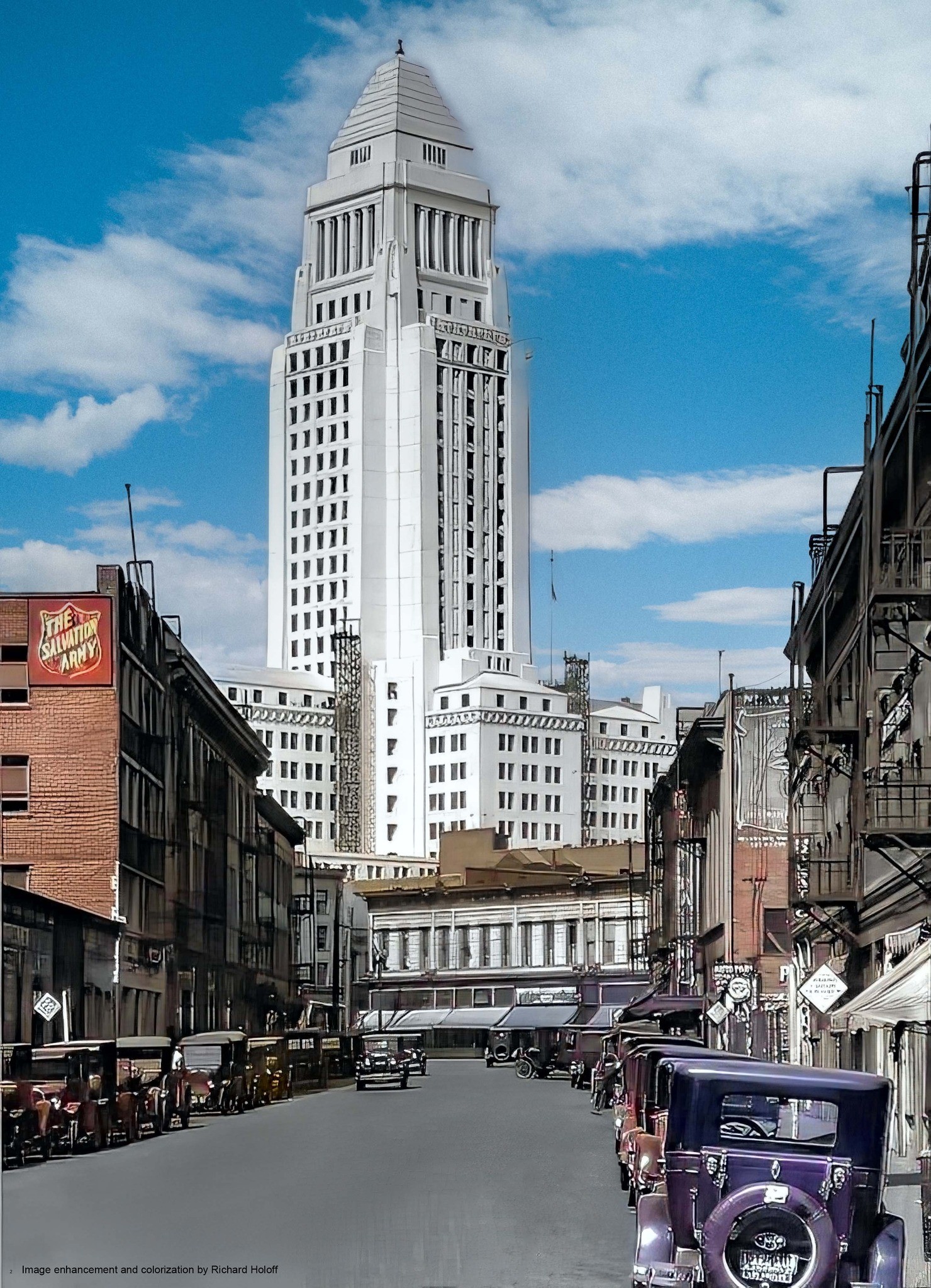 |
|
| (1928)* - View showing the nearly completed City Hall building as seen from Weller Street (now Onizuka Street, Little Tokyo). Metal scaffolding can be seen in place near the base of the tower. On the left can be seen the Salvation Army. Image enhancement and colorization by Richard Holoff. |
Historical Notes When it opened its doors in 1928, the new Los Angeles City Hall was the tallest building in the city and undeniably beloved by its people—and they hadn’t even been inside yet. Indeed, more than a half-million people lined the streets to celebrate the dedication of the monolith that symbolized Los Angeles’s successful transition from West Coast outpost to world-class metropolis. |
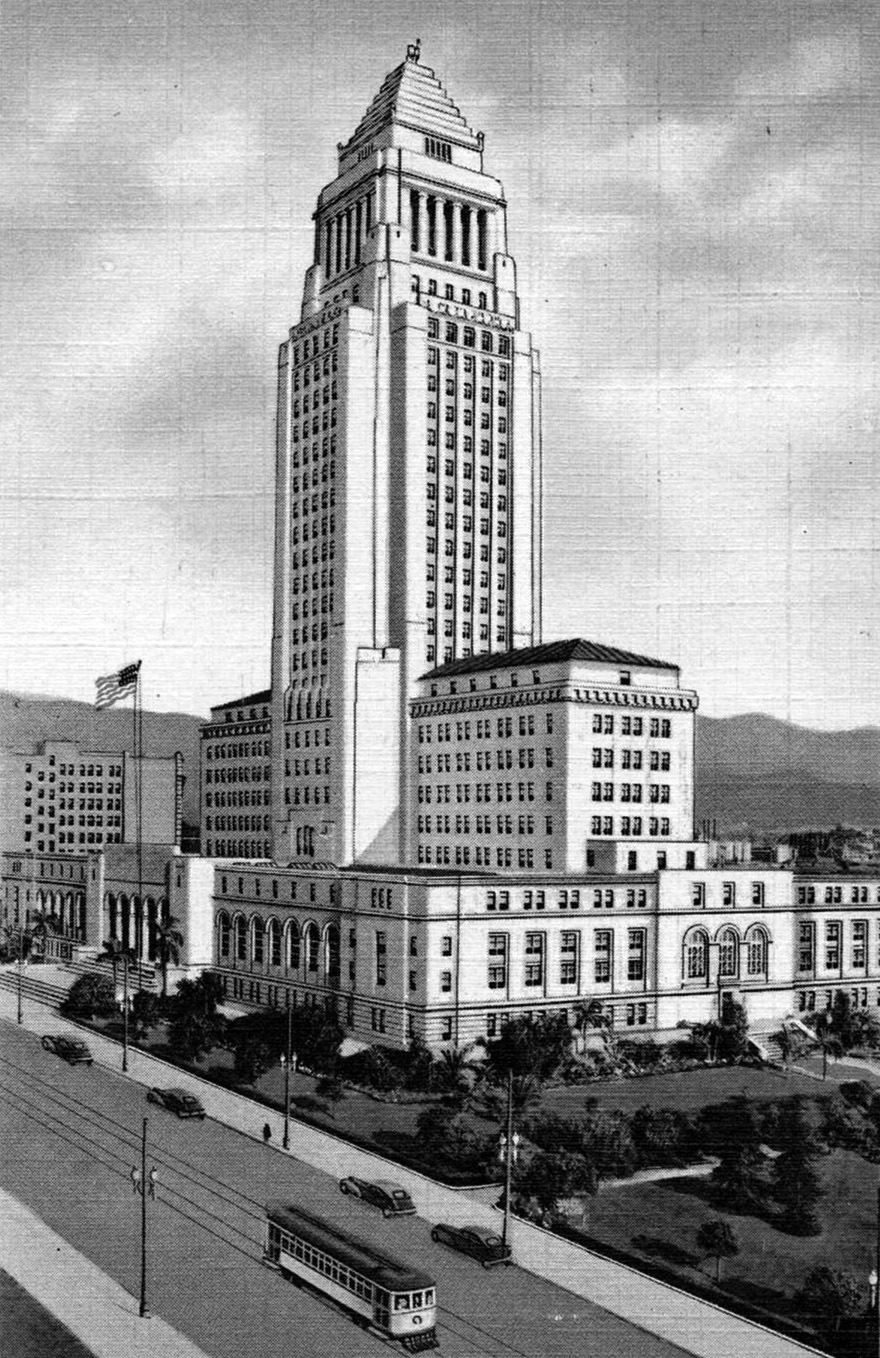 |
|
| (ca. 1938)* – Postcard view showing Los Angeles City Hall with Spring Street in the foreground. |
Pre-Construction
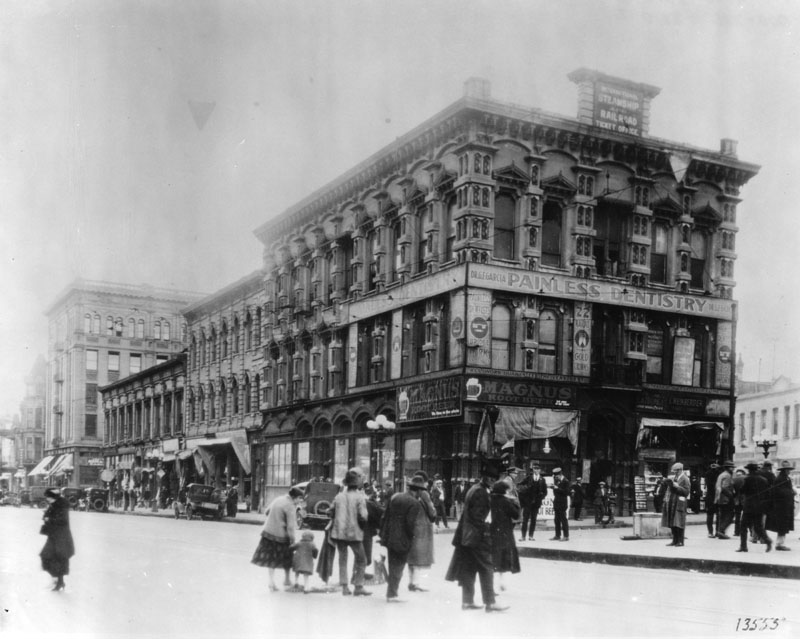 |
|
| (ca. 1926)* - View showing the Temple Block at the intersection of Spring, Main, and Temple streets. This would become site of today's City Hall. Ground was broken on March 4, 1926. |
Historical Notes For decades the triangle-shaped Temple Block at the intersection of Main, Spring, and Temple streets was the commercial heart of Los Angeles. One of the city’s first stores was established right here in the 1850’s by Johnathan Temple (thus Temple Street). |
Construction Begins
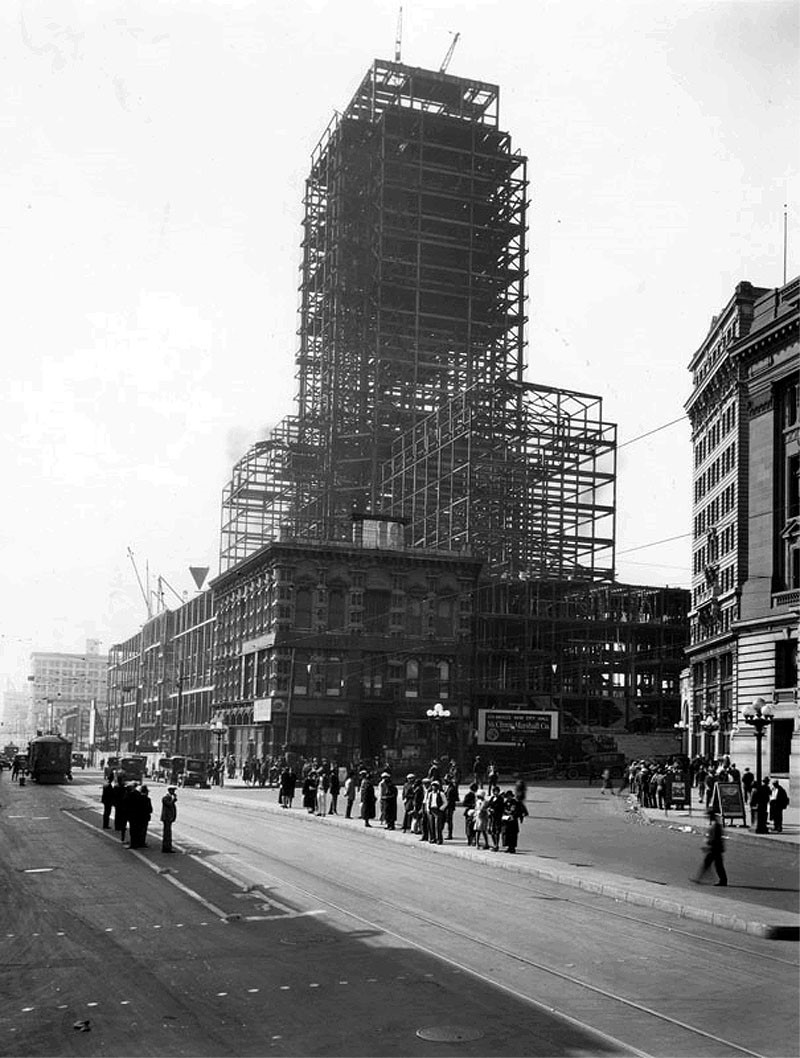 |
|
| (1927)* - Steel framing goes up quickly as the new City Hall takes form, dwarfing the historic corner building of Temple Block. |
Historical Notes After authorizing a bond issue on June 5, 1923, the city commissioned John Parkinson, Albert C. Martin, and John C. Austin as architects in August, 1925. Parkinson was responsible for the concept and architectural design of the building; Martin, the structural design; and Austin, the working drawings and general administration of the project.^ |
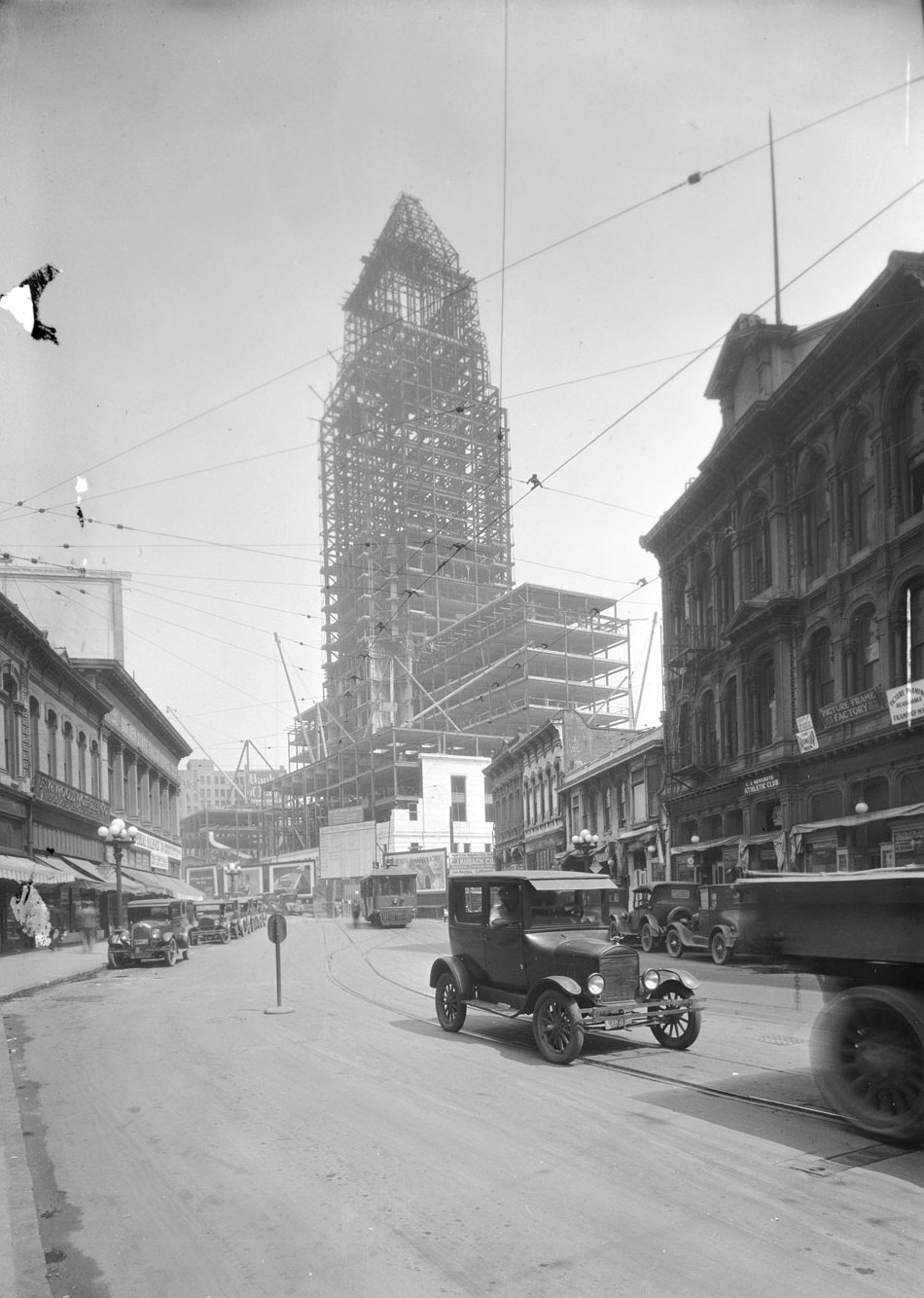 |
|
| (1927)* - View showing early model cars and streetcar with City Hall under construction in the background. The structure's steel framing is nearly complete. |
Historical Notes The new 28-story high-rise was replacing the old 1888-built City Hall located on Broadway between 2nd and 3rd Streets. That building had replaced a one-story adobe City Hall, formerly the old Rocha House, on the northeast corner of Spring and Court Streets. |
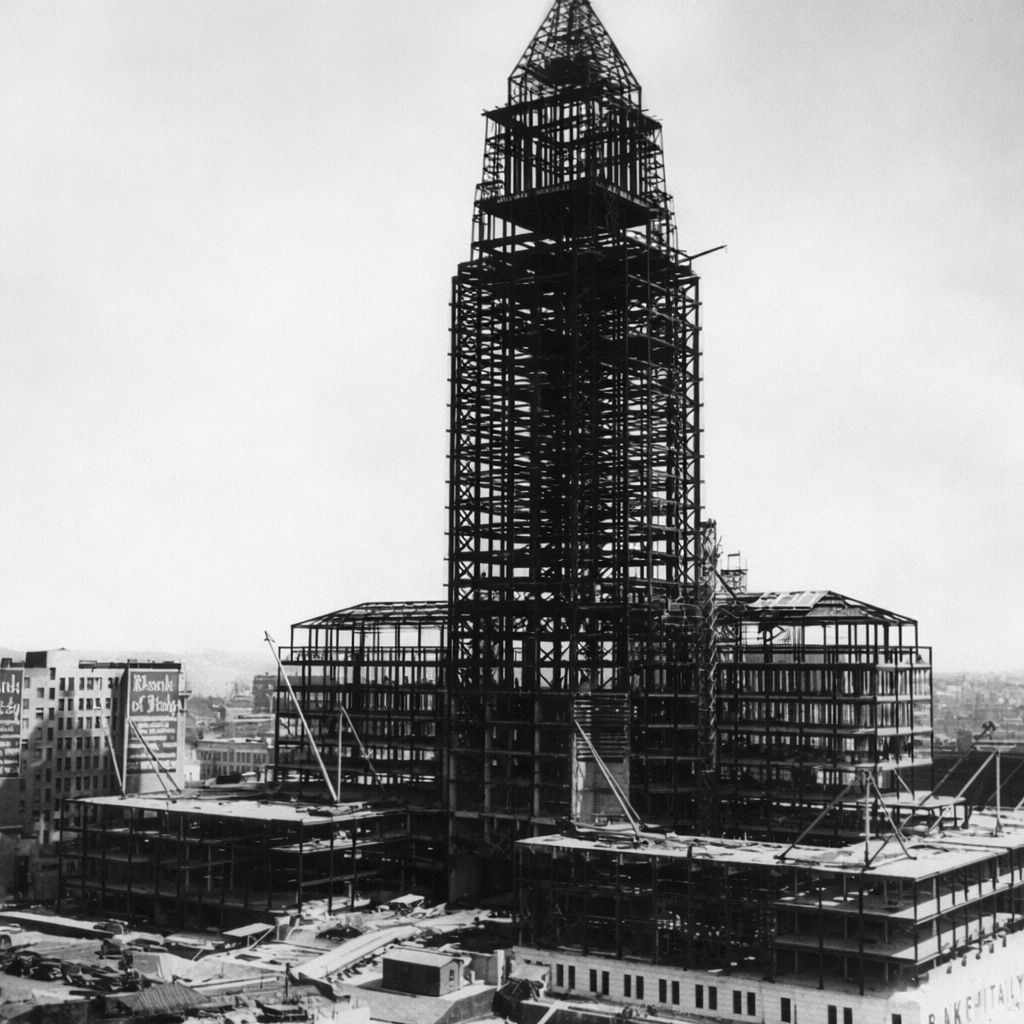 |
|
| (1927)* - Exterior stone begins to be added during construction. |
Historical Notes At 454 feet high the new City Hall would become Los Angeles' tallest building for over 30 years. |
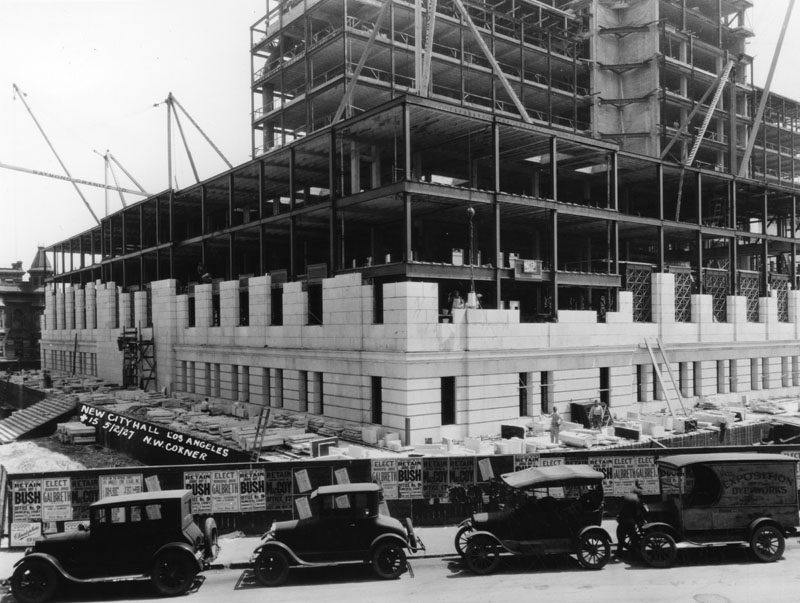 |
|
| (1927)* - View showing northwest corner of the new City Hall building, May 2, 1927, during construction. |
Historical Notes The concrete in the City Hall tower was made with sand from each of California's 58 counties and water from its 21 historical missions. |
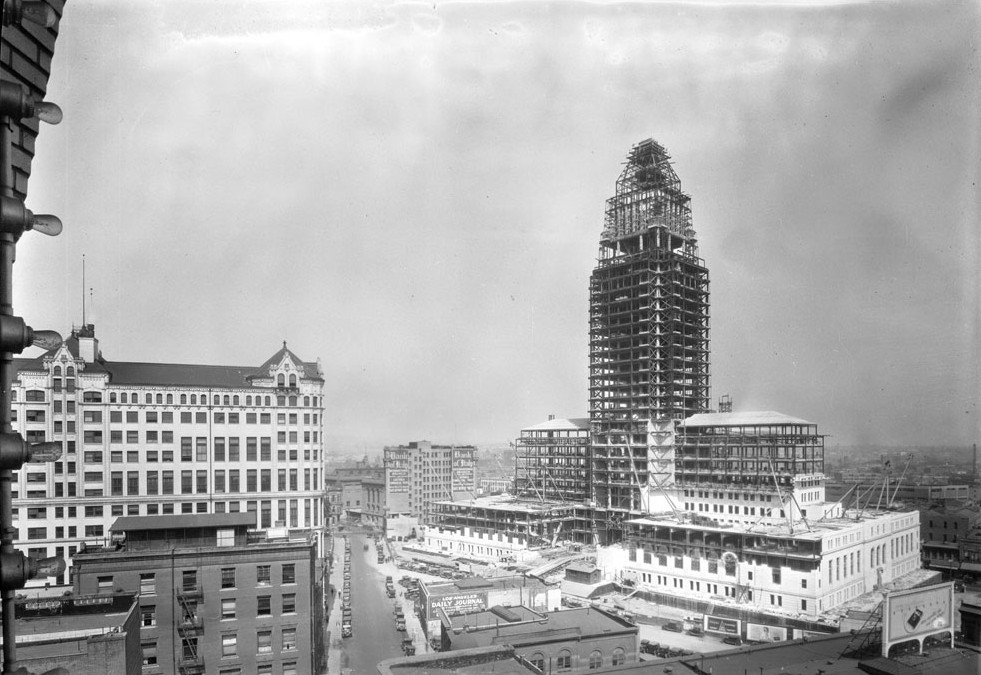 |
|
| (1927)^^ - Los Angeles City Hall beginning to take form, 200 N. Spring Street. |
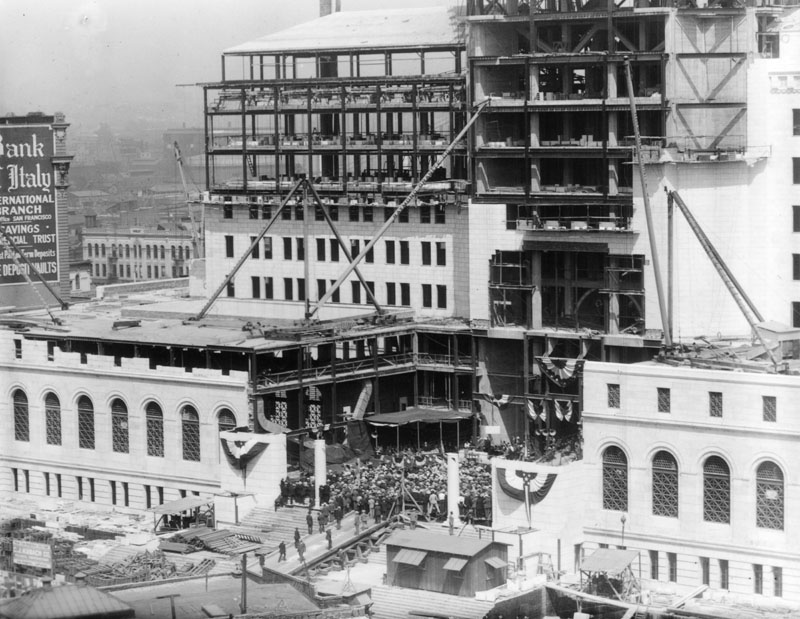 |
|
| (1927)* - Ceremony marking halfway completion of the new Los Angeles City Hall. |
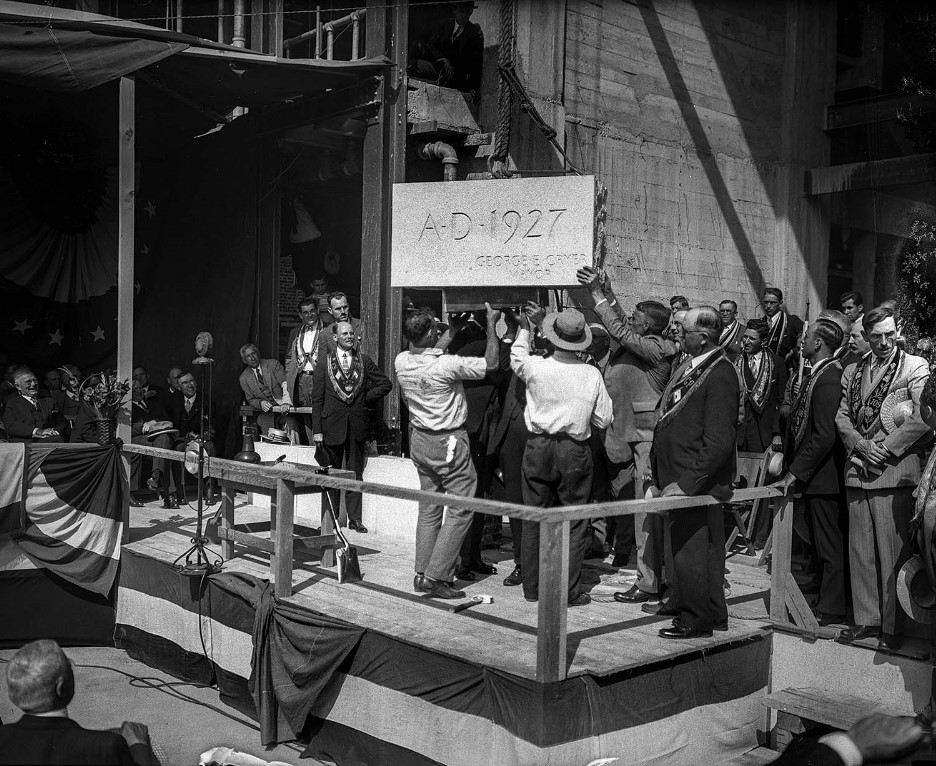 |
|
| (1927)* - Cornerstone for the new Los Angeles City Hall being lowered into position. |
Historical Notes A story accompanying this photo in the June 23, 1927, Los Angeles Times reported: “The corner-stone of Los Angeles’ new City Hall was laid at 2 o’clock yesterday afternoon. The ceremonies were conducted by the Native Sons of the Golden West, with Charles A. Thompson, Grand President of the order presiding. Appropriate speeches were made by Gov. (Clement) Young, Mayor (George) Cryer, President McGarry of the Chamber of Commerce and Edward J. Delorey, who acted as chairman. … Just before the corner-stone was lowered into position, a copper box was placed inside which contained more than a score of historical documents and other articles. Among these was an autographed photograph of Mayor Cryer, his annual message, the charter of Los Angeles, a history of the California pioneers, a copy of the city budget for 1927-28, an account of the discovery of gold in 1848, three gold nuggets and numerous other articles. The Governor joined the Mayor at the old City Hall and the procession to the new structure was led by the Firemen’s Band. Several thousand persons witnessed the ceremonies, The program was broadcast.” |
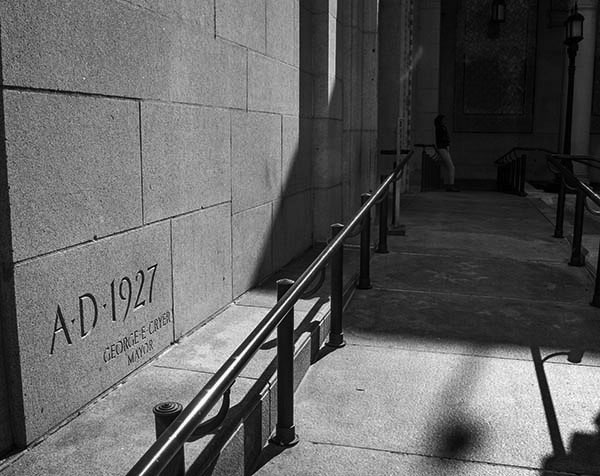 |
|
| (2015)* - The cornerstone for Los Angeles City Hall is to the left of the historical entrance – now closed – off Spring St. Photo by Scott Harrison |
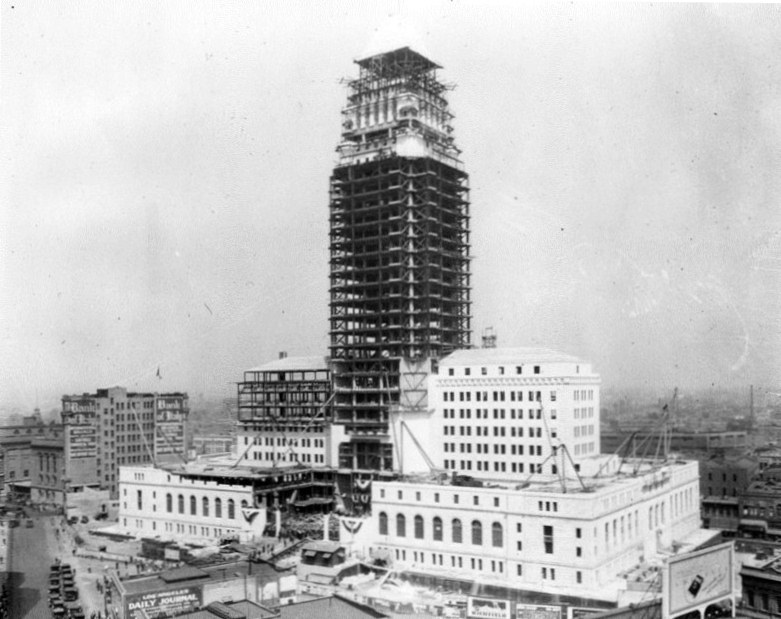 |
|
| (1927)* - View of the new Los Angeles City Hall more than halfway completed. |
Historical Notes City Hall's distinctive tower was based on the purported shape of the Mausoleum of Mausolus and shows the influence of the Los Angeles Central Library, completed soon before the structure was started.*^ |
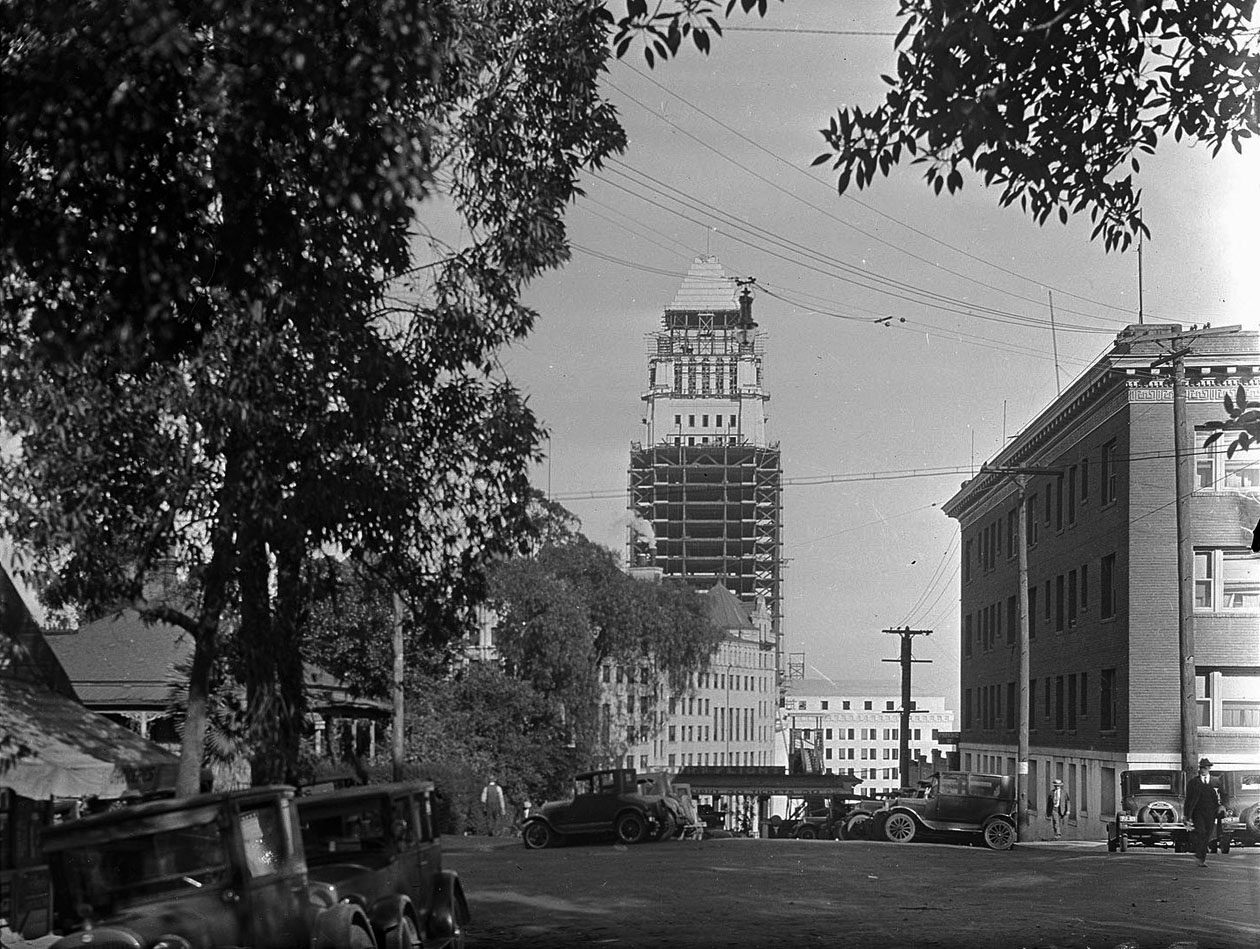 |
|
| (1928)* – City Hall under construction as seen from the upper terminus of Angels Flight at 3rd and Olive. |
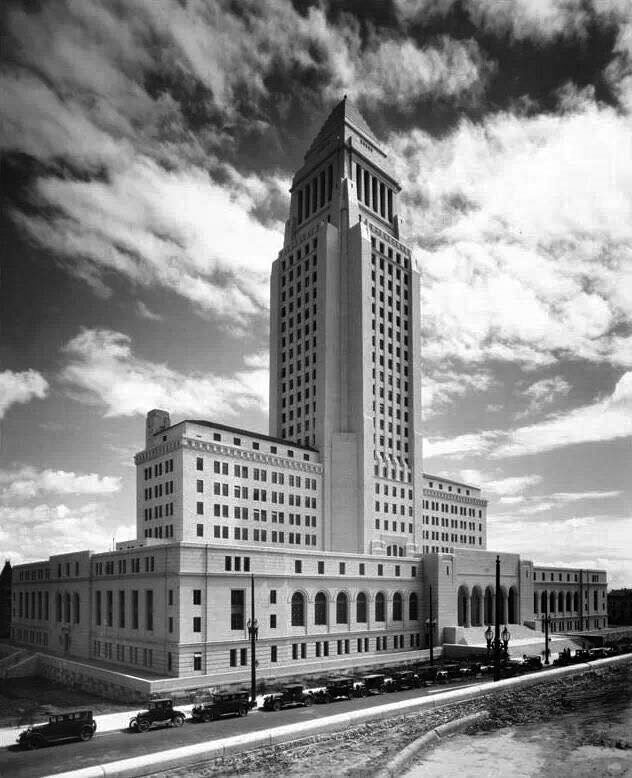 |
|
| (1928)* - City Hall near the last stage of completion, prior to landscaping. After completion City Hall was LA's tallest building until 1964. |
Historical Notes Prior to the late 1950s the Charter of the City of Los Angeles did not permit any portion of any building other than a purely decorative tower to be more than 150 feet. Therefore, from its completion in 1928 until 1964, the City Hall was the tallest building in Los Angeles, and shared the skyline with only a few structures having decorative towers, including the Richfield Tower and the Eastern Columbia Building. |
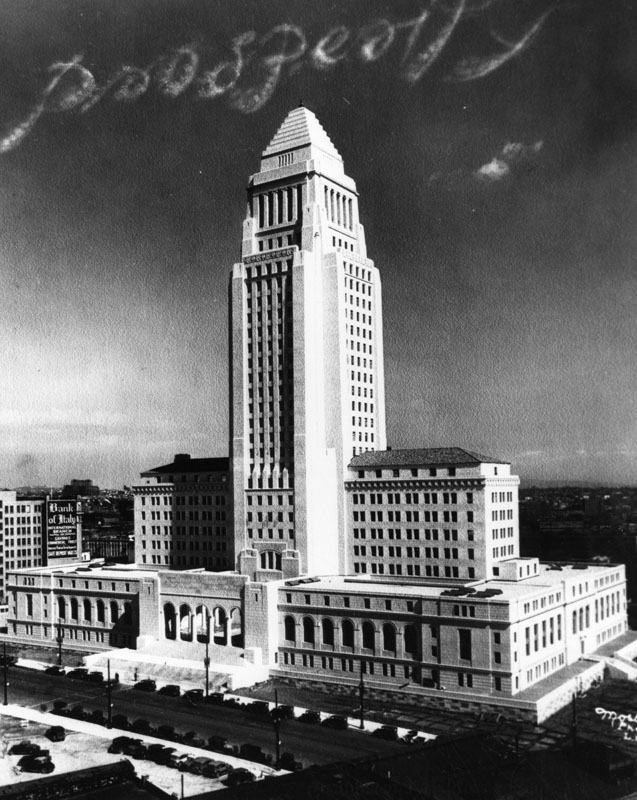 |
|
| (1928)* - View of the new Los Angeles City Hall getting prepared for its grand opening. Sky writing over the building reads "prosperity." Shows the blended Classical, Mediterranean, Moderne style building with the 450 foot tower, granite at lower levels and terra cotta above. Donald and John Parkinson, John C. Austin, Albert C. Martin, Austin Whittlesey, architects. |
Historical Notes An image of City Hall has been on Los Angeles Police Department badges since 1940. |
Opening Ceremony
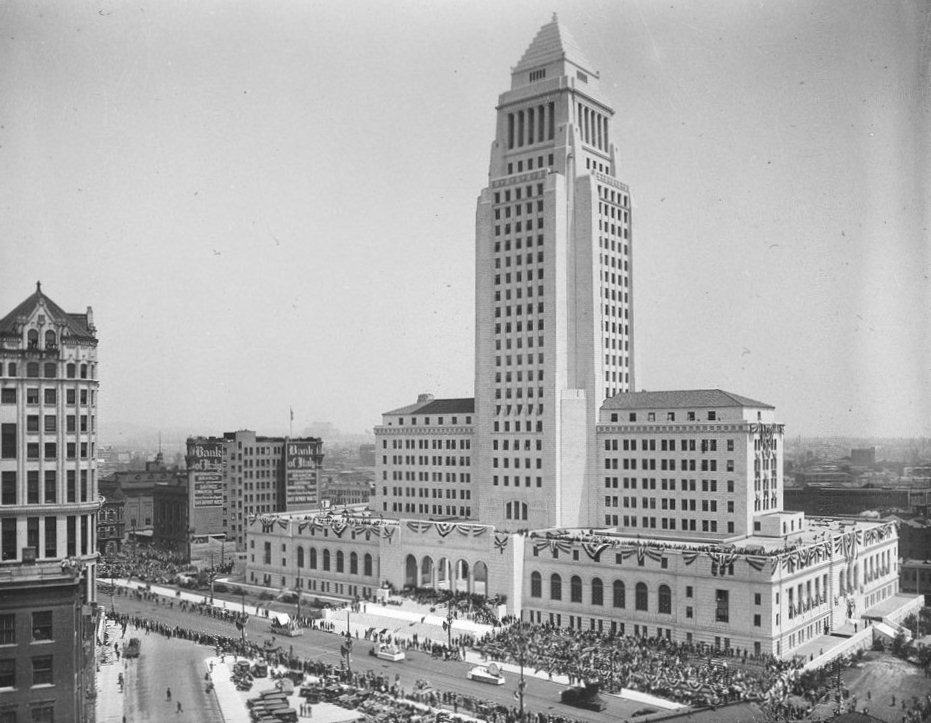 |
|
| (1928)^^ - View of Los Angeles City Hall decorated with banners for its opening ceremony. A crowd of people are gathered at the curb, bleachers are full of spectators, and a parade is in progress on Spring Street. |
Historical Notes The big dedication, overseen by Sid Grauman and attended by an estimated 15,000 people, featured emceeing by Joseph Schenck and speeches by Mayor George E. Cryer and San Francisco Mayor James Rolph, Jr. After Rolph spoke, Irving Berlin sang, as did “Chief Yowlache, the Yakima Indian; Elsa Alsen, the grand opera singer; the Mexican chorus of Los Angeles, in costume; Virgil Johannson, and others." |
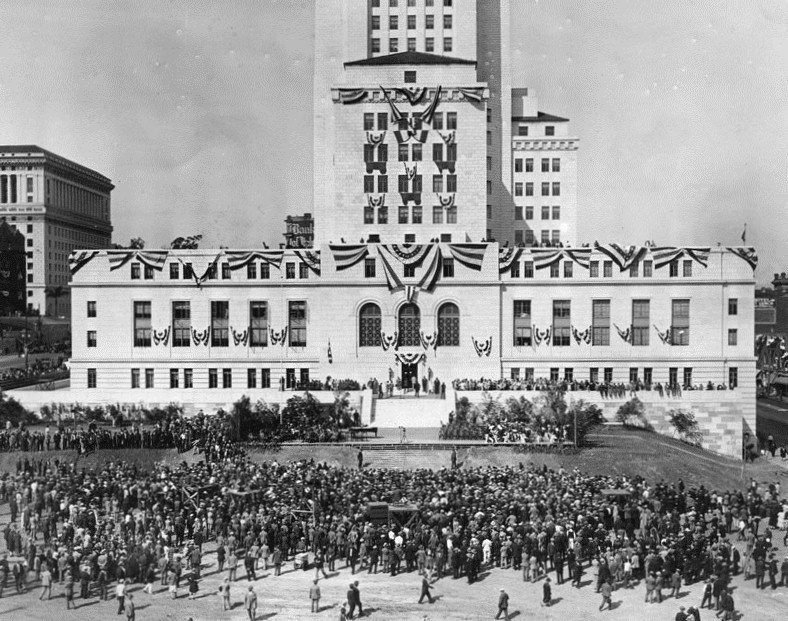 |
|
| (1928)* - Daytime dedication ceremony of the newly completed Los Angeles City Hall. Photograph taken of the side facing 1st Street. |
 |
|
| (1928)* - Tens of thousands of people show up for the parade celebrating the grand opening of the new Los Angeles City Hall.. |
Historical Notes A parade with 32,000 marchers, 34 bands, and 150 floats marked the occasion. Promptly at 7 p.m. Pacific Time on April 26, 1928, President Calvin Coolidge pressed a gold telegraph key in the White House in Washington, D.C., sending the signal cross-country to officially switch on the Lindbergh Beacon atop Los Angeles City Hall, its brilliant beam of light shooting a brilliant message into the night sky: Los Angeles City Hall was complete. The news spread round the world. The next day, when its doors were flung open, 67,000 people poured through its corridors. |
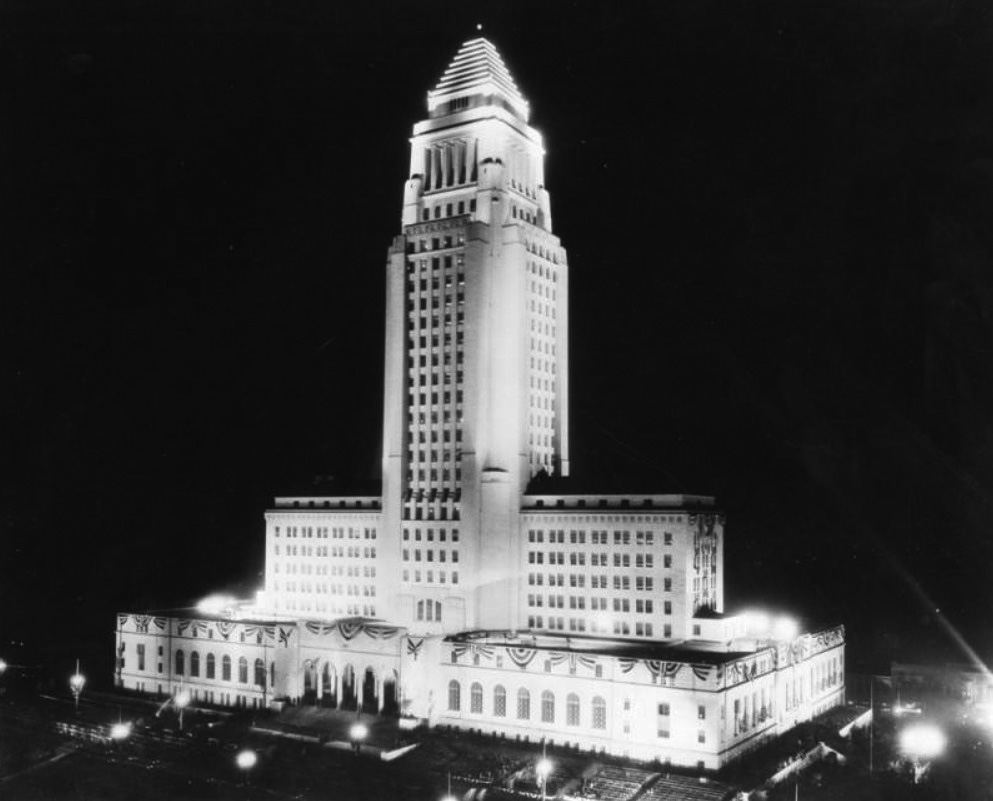 |
|
| (1928)* - Nighttime view of the opening of City Hall with building decorated and lit up. An image of City Hall has been on Los Angeles Police Department badges since 1940. |
Historical Notes The following historical timeline lists the buildings used by City Council, also known as City Hall, since 1850, when Los Angeles was incorporated as a municipality: ◆ 1850 - 1853 - used rented hotel and other buildings for City meetings ◆ 1853 - rented adobe house (aka Rocha Adobe) on Spring Street - across from current City Hall (now parking lot for Clara Shortridge Foltz Criminal Justice Center). The buliding was shared with the County who used it as a Court House. ◆ 1861 - moved into John Temple's Clocktower Market Building, but only stayed for less than a year before the County Court House moved-in ◆ 1861 - 1884 - relocated back to the Rocha Adobe and stayed for over 20 years ◆ 1884 - 1888 - moved to new City Hall Building at South Spring Street and West 2nd Street (site of current Los Angeles Times Building) ◆ 1888 - 1928 - moved to new Romanesque Revival Building on 226-238 South Broadway between 2nd Street and 3rd Street; demolished in 1928 and now site of parking lot between LA Times Parking structure and 240 Broadway. ◆ 1928 - moved to current City Hall Building |
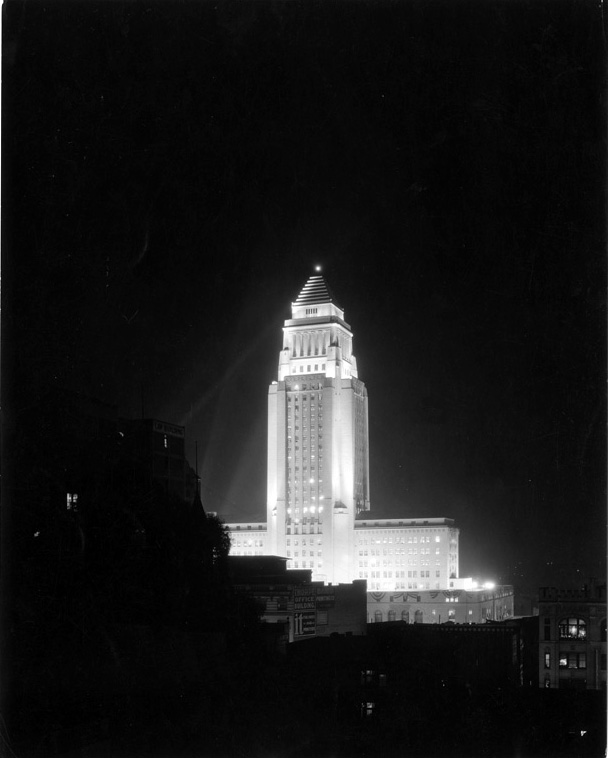 |
|
| (ca. 1928)^*# - Nighttime view of City Hall as seen from Bunker Hill. |
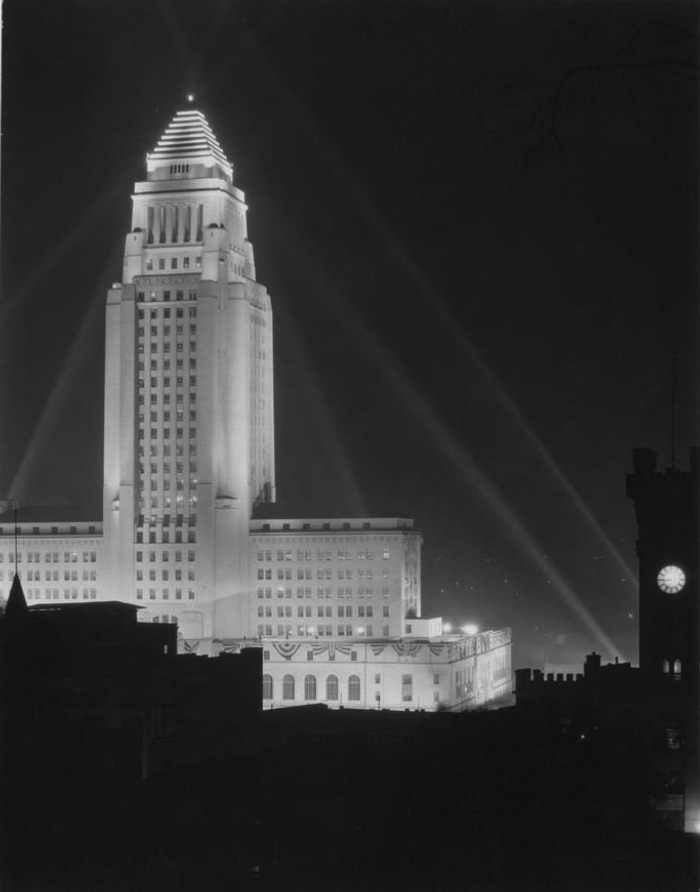 |
|
| (1928)* – View looking down from Bunker Hill toward City Hall during opening ceremonies. The LA Times Building clock tower can be seen at right. |
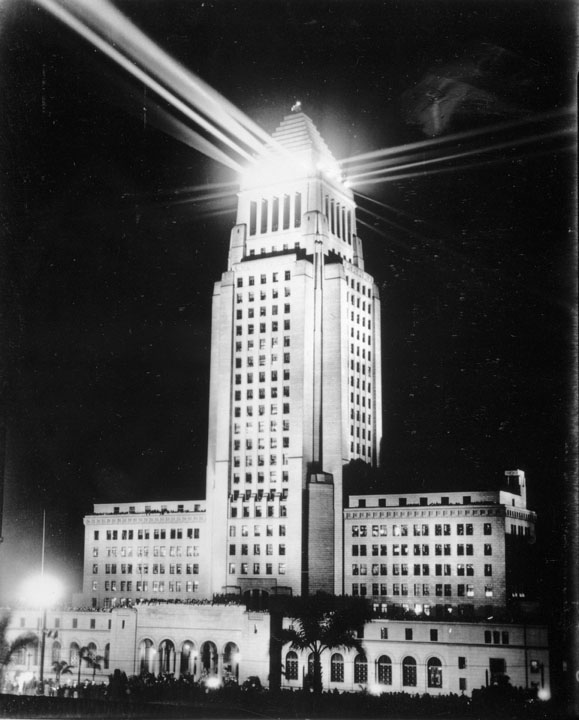 |
|
| (April 26, 1928)* - View showing Opening Ceremony of the Los Angeles City Hall with multiple spotlights shining out of tower. |
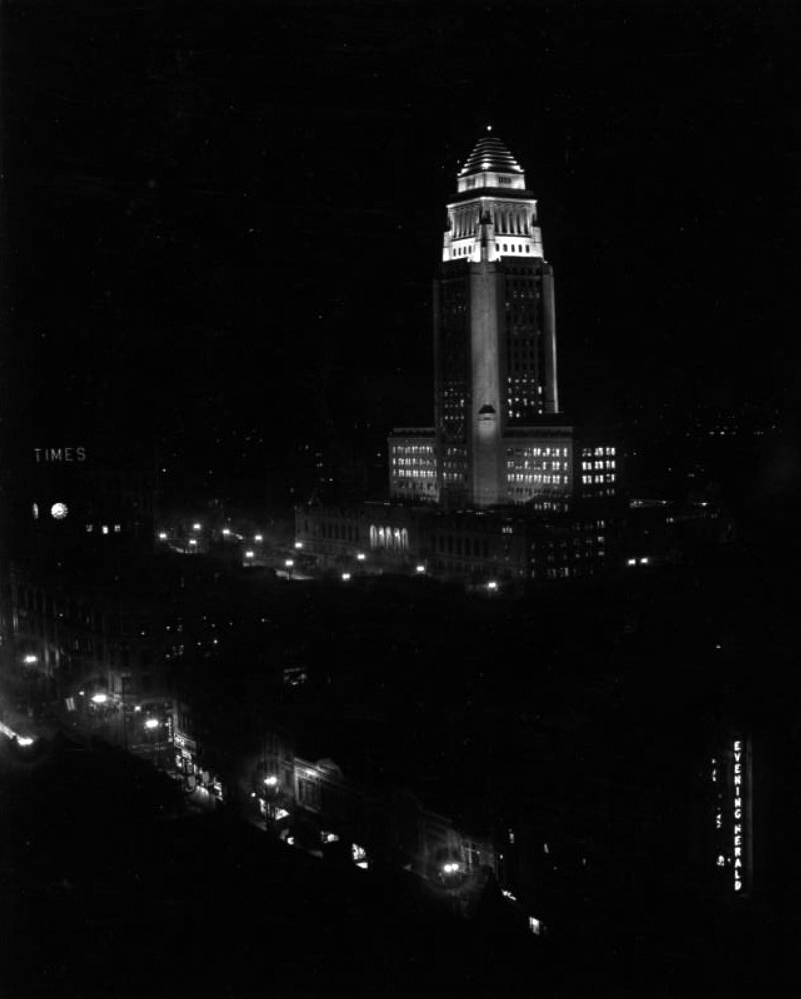 |
|
| (1928)* – Night view showing Los Angeles City Hall in downtown Los Angeles. The LA Times Building on the N/E corner of Broadway and 1st Street can be seen at left, with the lighted sign "Times." |
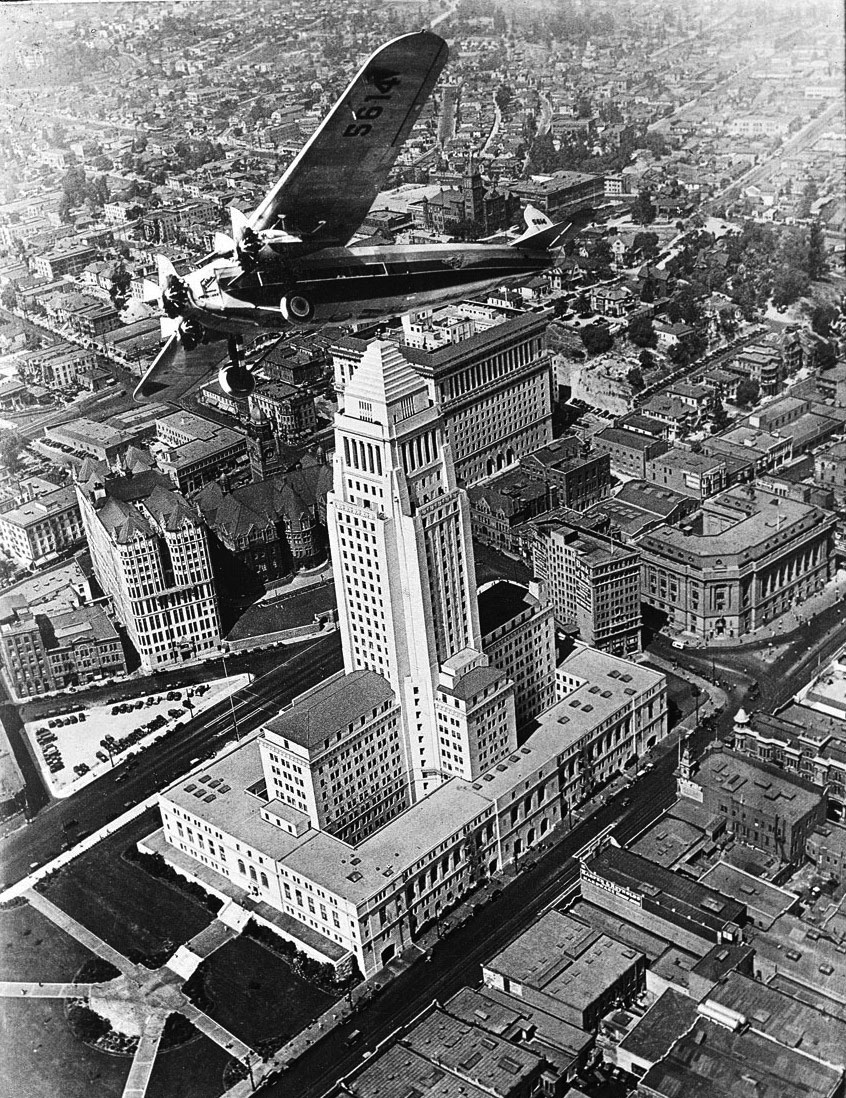 |
|
| (ca. 1929)^^ - View looking northwest showing an airplane (Fokker F.10) buzzing over City Hall. |
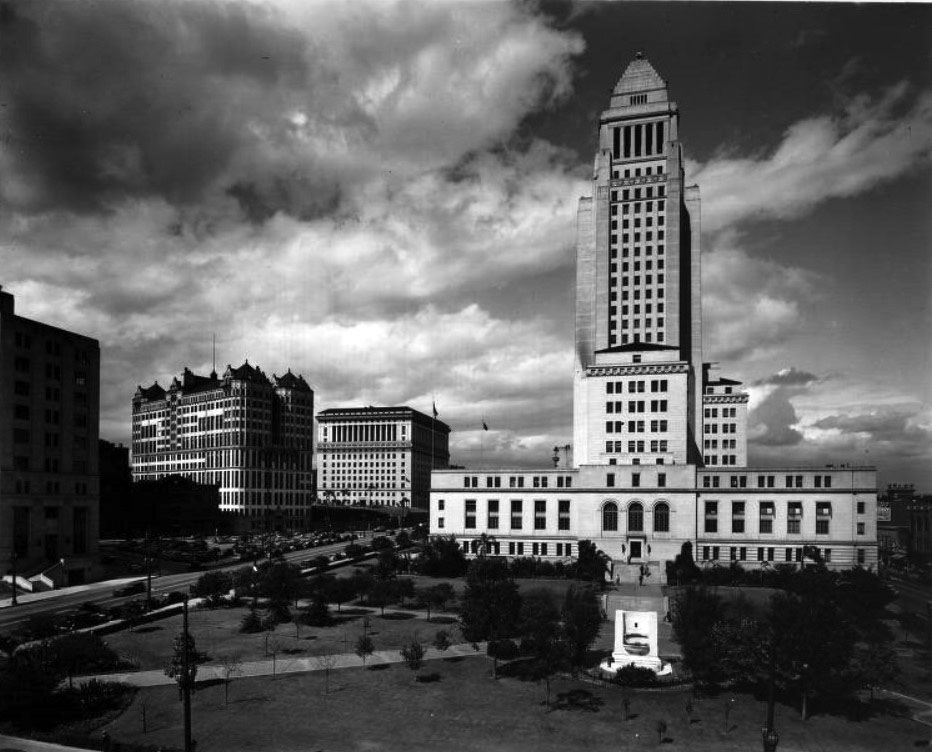 |
|
| (ca. 1930s)* - View of City Hall facing north from First Street. To the west on Spring Street are the old State Building, Hall of Records, and Hall of Justice. |
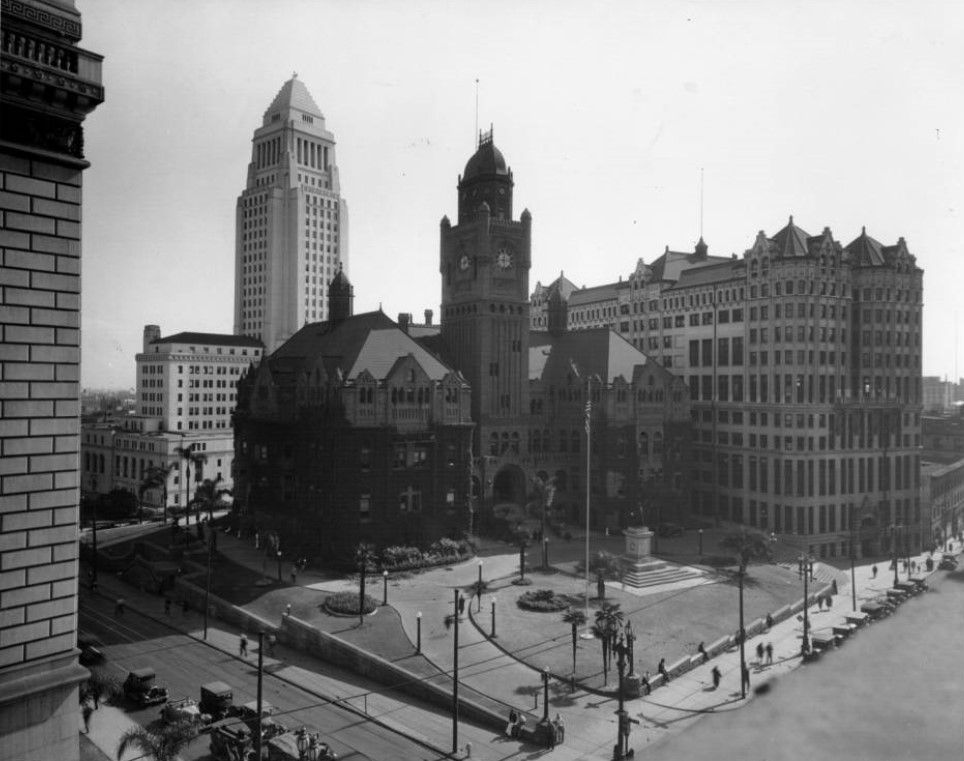 |
|
| (1930)^^ - View looking southeast at the intersection of Temple and Broadway. The County Courthouse stands at center with the Hall of Records to its right. City Hall towers above both in the background. |
Historical Notes The old LA County Courthouse was demolished in 1936. The Hall of Records stood until 1973. |
Before and After
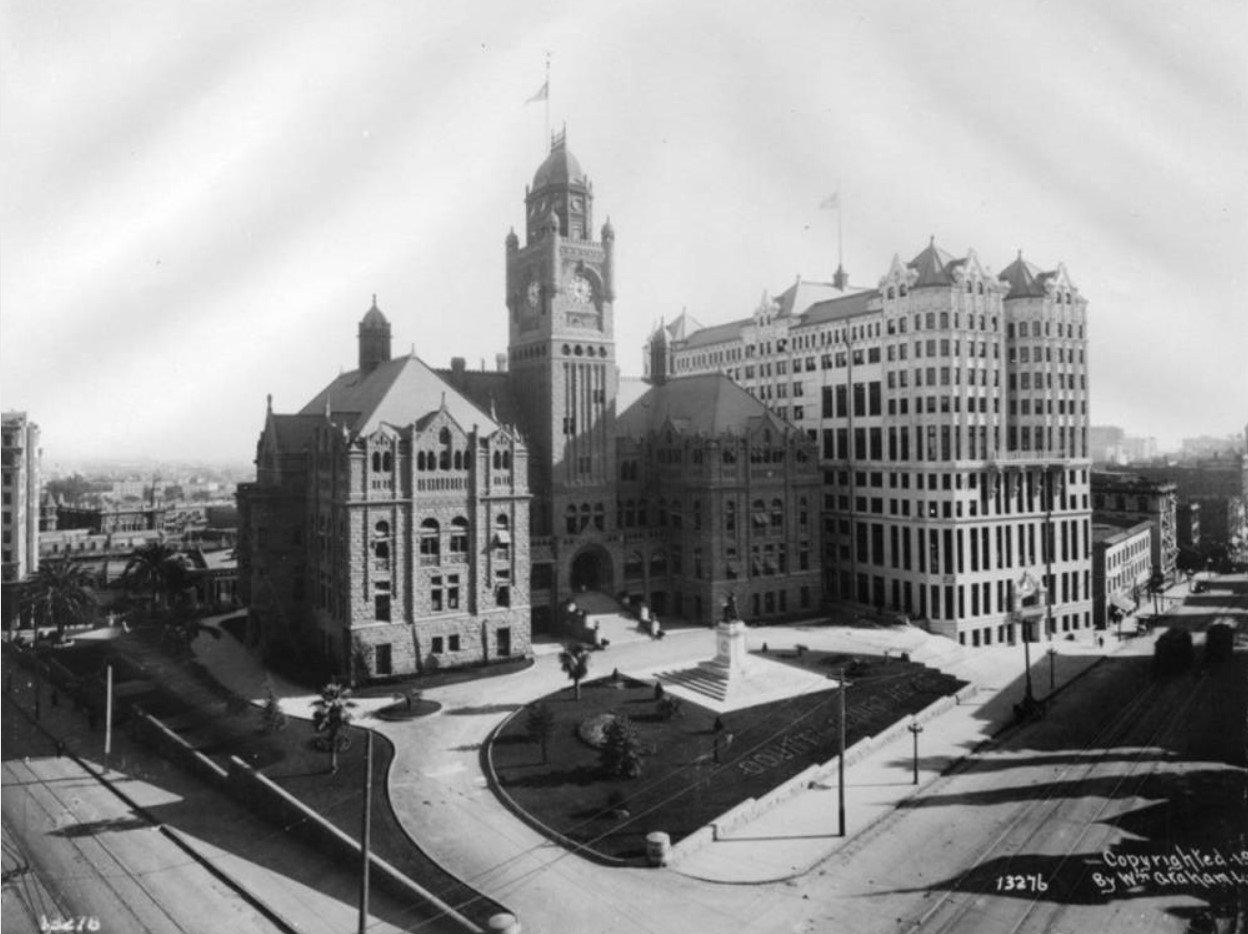 |
|
 |
|
| (1911 - 1930)^^ - View looking toward the southeast corner of Temple and Broadway before and after City Hall was built (1928). |
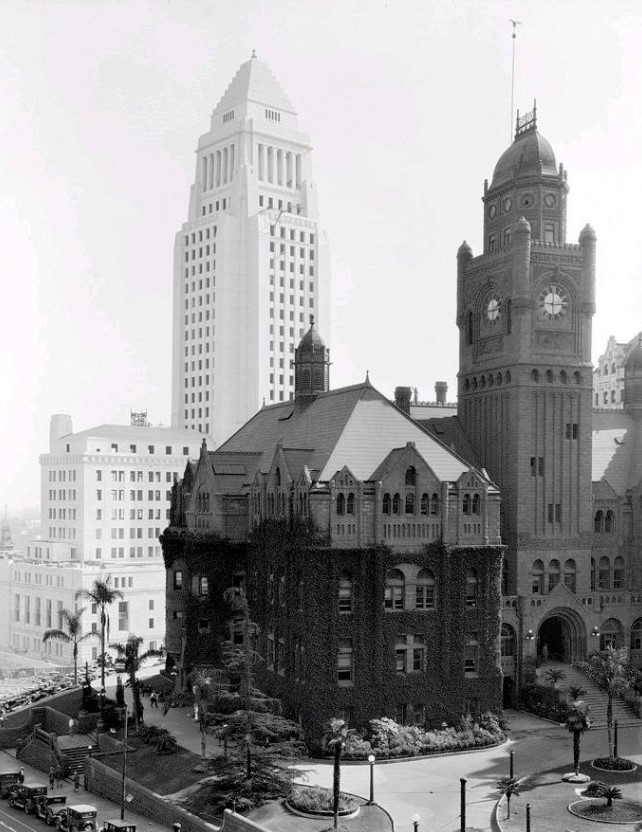 |
|
| (ca. 1930)* - A great shot of the Los Angeles’ City Hall in the background (which is still with us, thankfully) and in the foreground the County Courthouse who somebody decided wasn’t worth saving (demolished in 1936). |
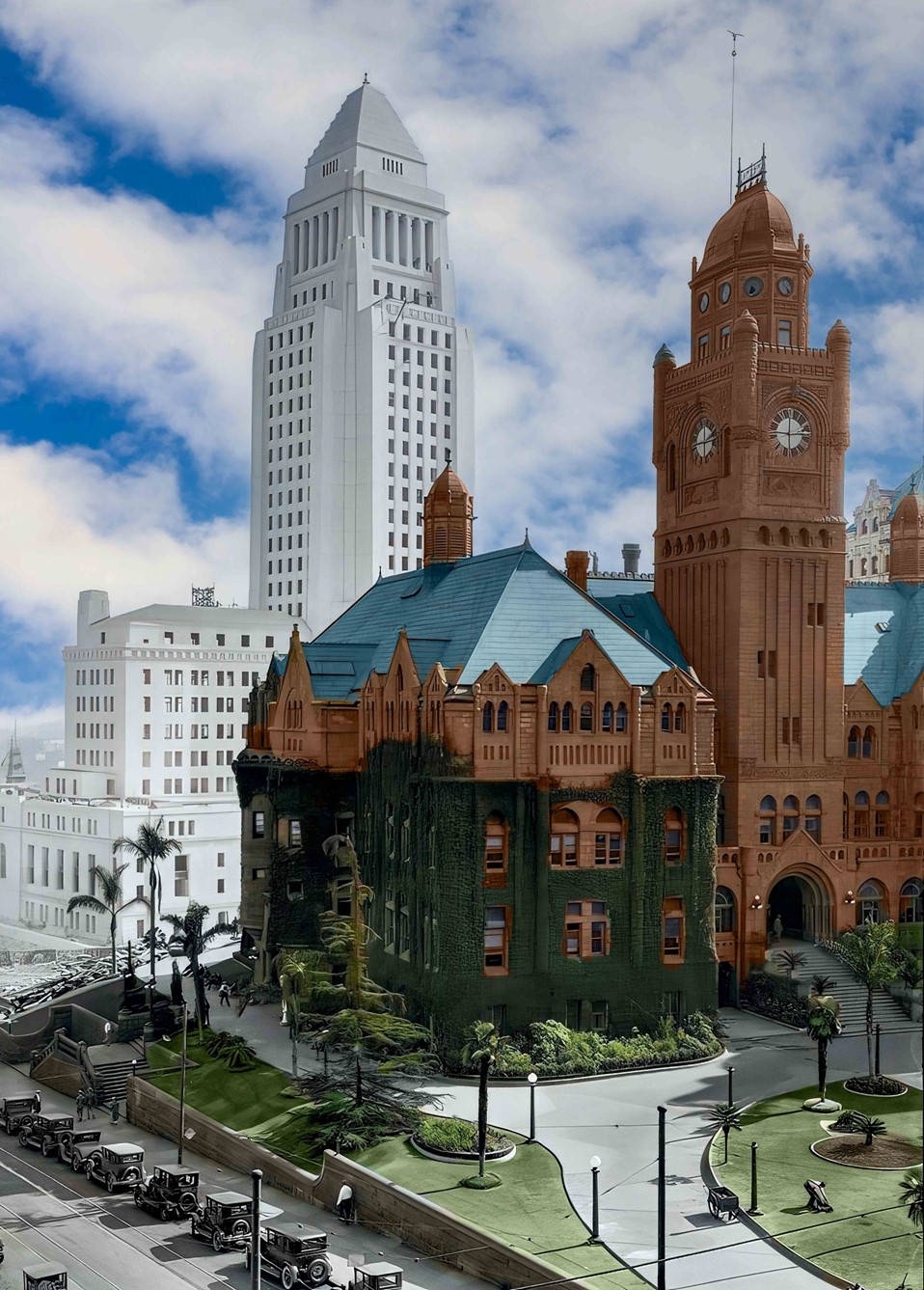 |
|
| (ca. 1930)* - A great shot of the Los Angeles’ City Hall in the background (which is still with us, thankfully) and in the foreground the County Courthouse who somebody decided wasn’t worth saving (demolished in 1936). Image enhancement and colorization by Richard Holoff. |
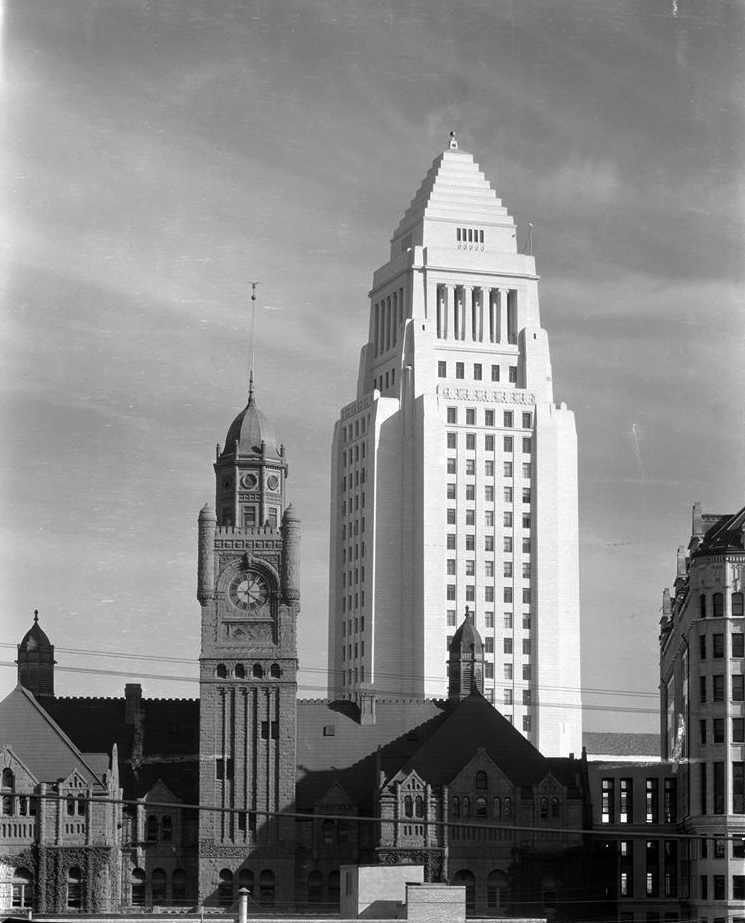 |
|
| (1928)* – Newly-opened City Hall towers over the old Los Angeles County Courthouse. Note the 3-level enclosed passageway between the Courthouse and the Hall of Records on the right. |
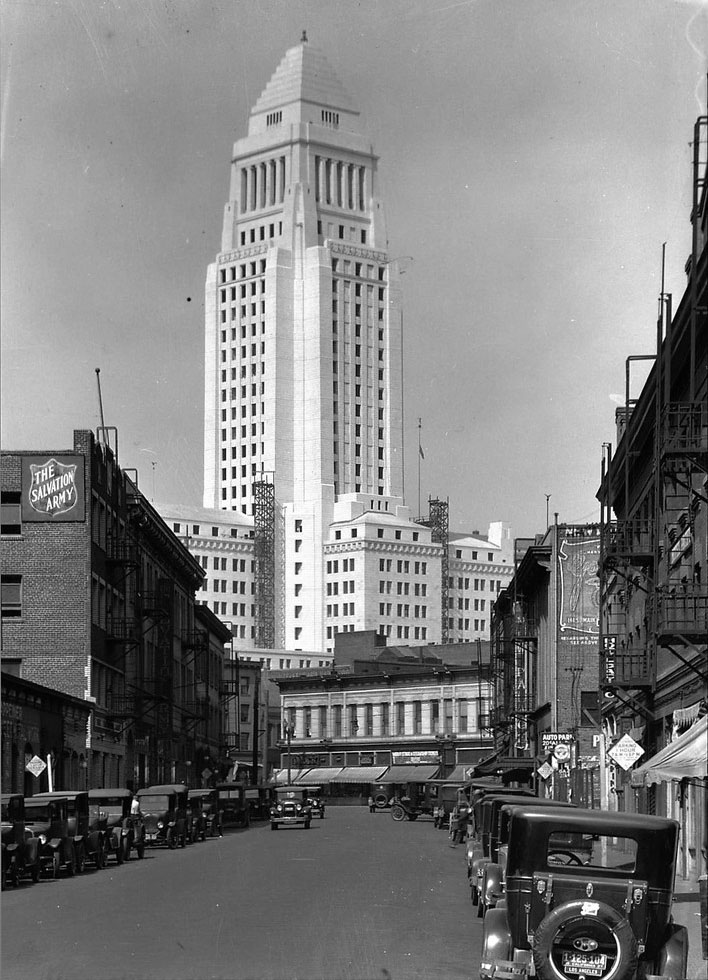 |
|
| (1928)* - View showing the nearly completed City Hall building as seen from Weller Street (now Onizuka Street, Little Tokyo). Metal scaffolding can be seen in place near the base of the tower. On the left can be seen the Salvation Army. |
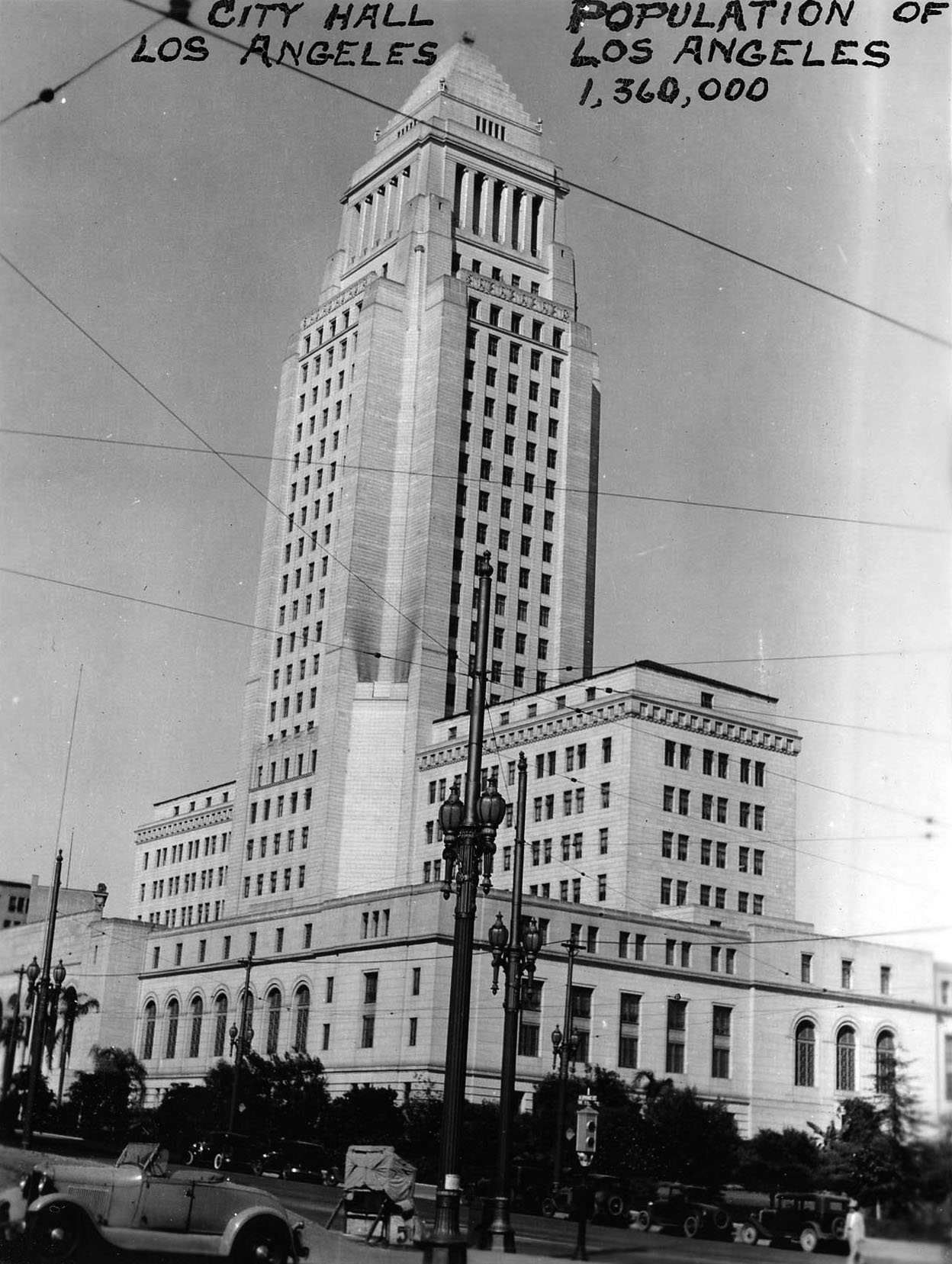 |
|
| (1934)* – View looking northeast toward City Hall from the intersection of Spring and 1st Street. |
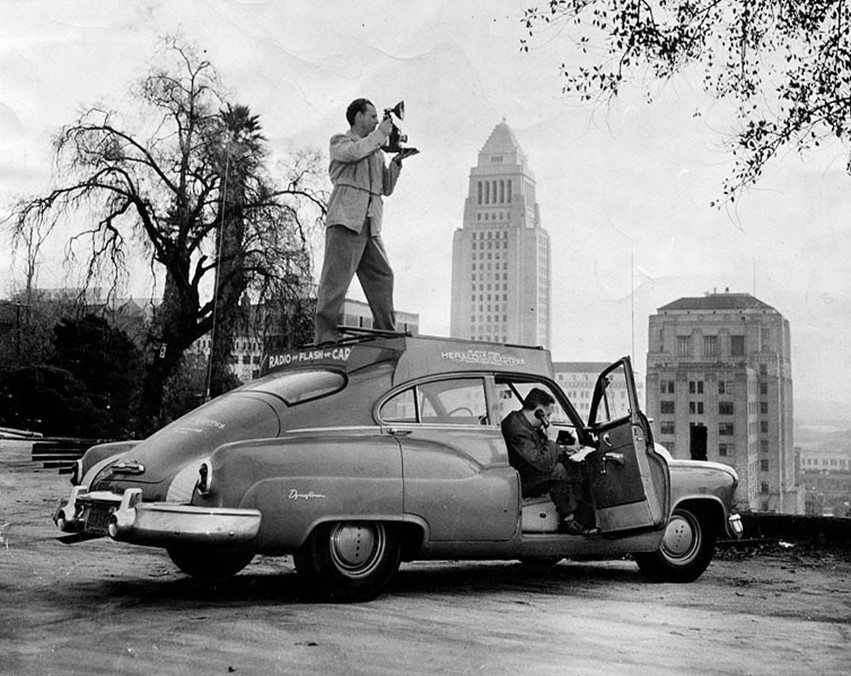 |
|
| (1949)^ – Reporter taking a picture from the top of a "Radio Flash Car" parked on Bunker Hill with City Hall and the California State Building in the background. |
Historical Notes For the reporter who needs to literally chase a story, the Los Angeles Herald-Express presents the “Radio Flash Car,” equipped with a radio telephone and a rooftop platform for photographers eager to get that quick shot. Whatever it takes to get the news “with the greatest speed.” |
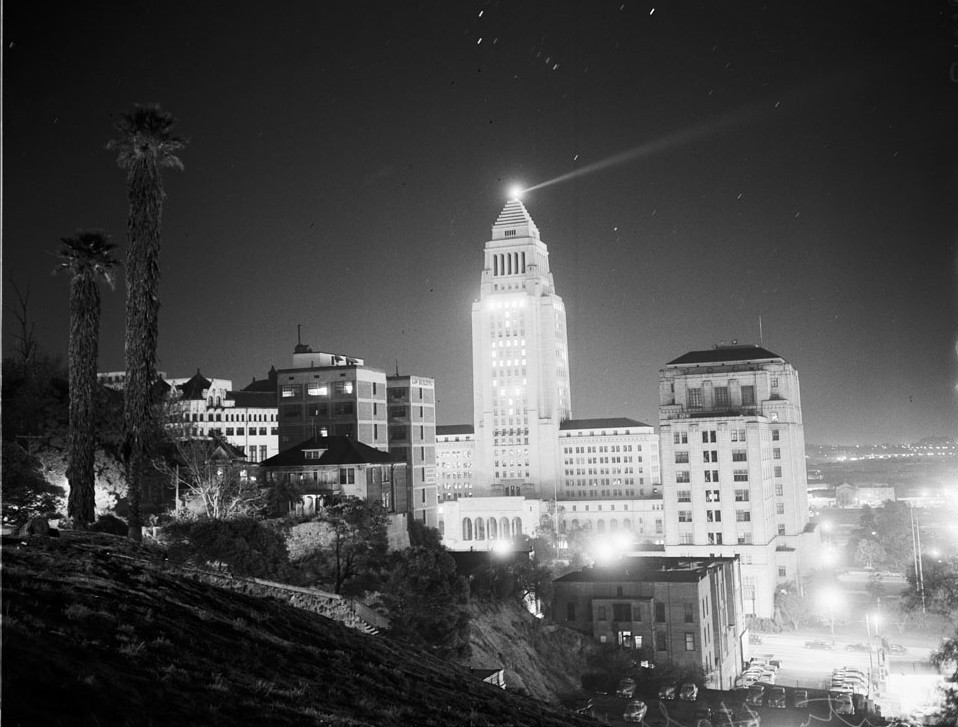 |
|
| (1951)^^ - The rotating beacon (The 'Lindbergh Beacon') is visible atop City Hall, and a portion of Bunker Hill can be seen on the lower left. At center-right is the old State Building. |
Historical Notes The Lindbergh beacon was installed on top of City Hall in 1928. Originally white, the light was replaced with a red light in 1931 after the U.S. Department of Commerce deemed the bright beacon a hazard to air safety. During WWII the light was turned off, and relit just a few of times more before being removed in the early 1950s. |
| (1930s)* – Postcard view showing City Hall and the Civic Center with the Lindbergh Beacon shining high into the sky. |
Historical Notes The Lindbergh beacon was rediscovered in the early 1990s. After restoration, it was put on display in the Tom Bradley International Terminal at LAX and relit for the first time in 45 years on April 22, 1992. The beacon was reinstalled on top of City Hall in 2001 and is lit on special occasions. |
| (1936)^ - The beacon light placed on the top of Los Angeles City Hall is lighted when power first arrived from Hoover Dam. |
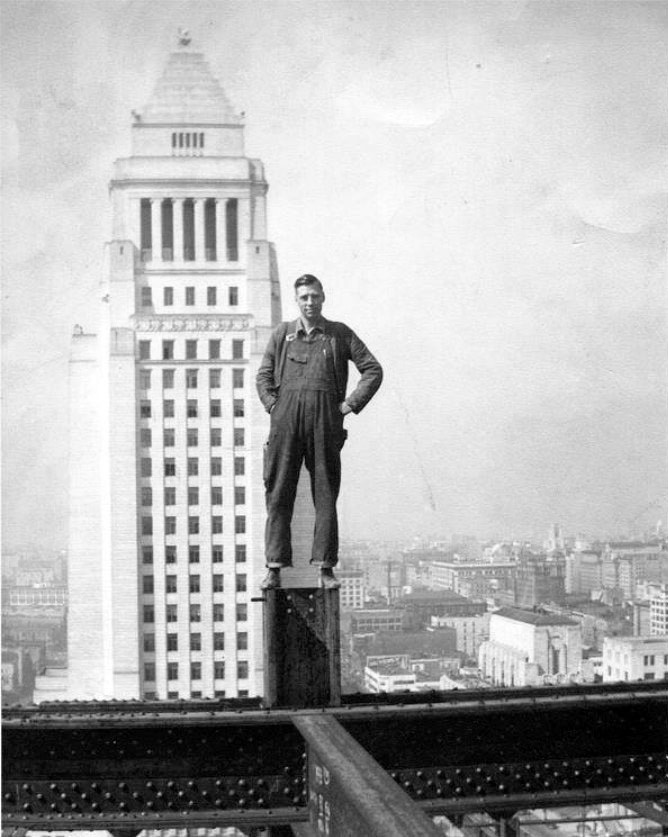 |
|
| (ca. 1938)* - View looking south toward City Hall showing a man standing fearlessly on top of steel framing for the new Federal Courthouse and U.S. Post Office Building*. Photo courtesy of Lauren Frobisher Scanlon who's grandfather, Frank McGuire, is seen in this photo. Vintage Los Angeles. |
Historical Notes The Federal Courthouse and U.S. Post Office Building was completed in 1940. |
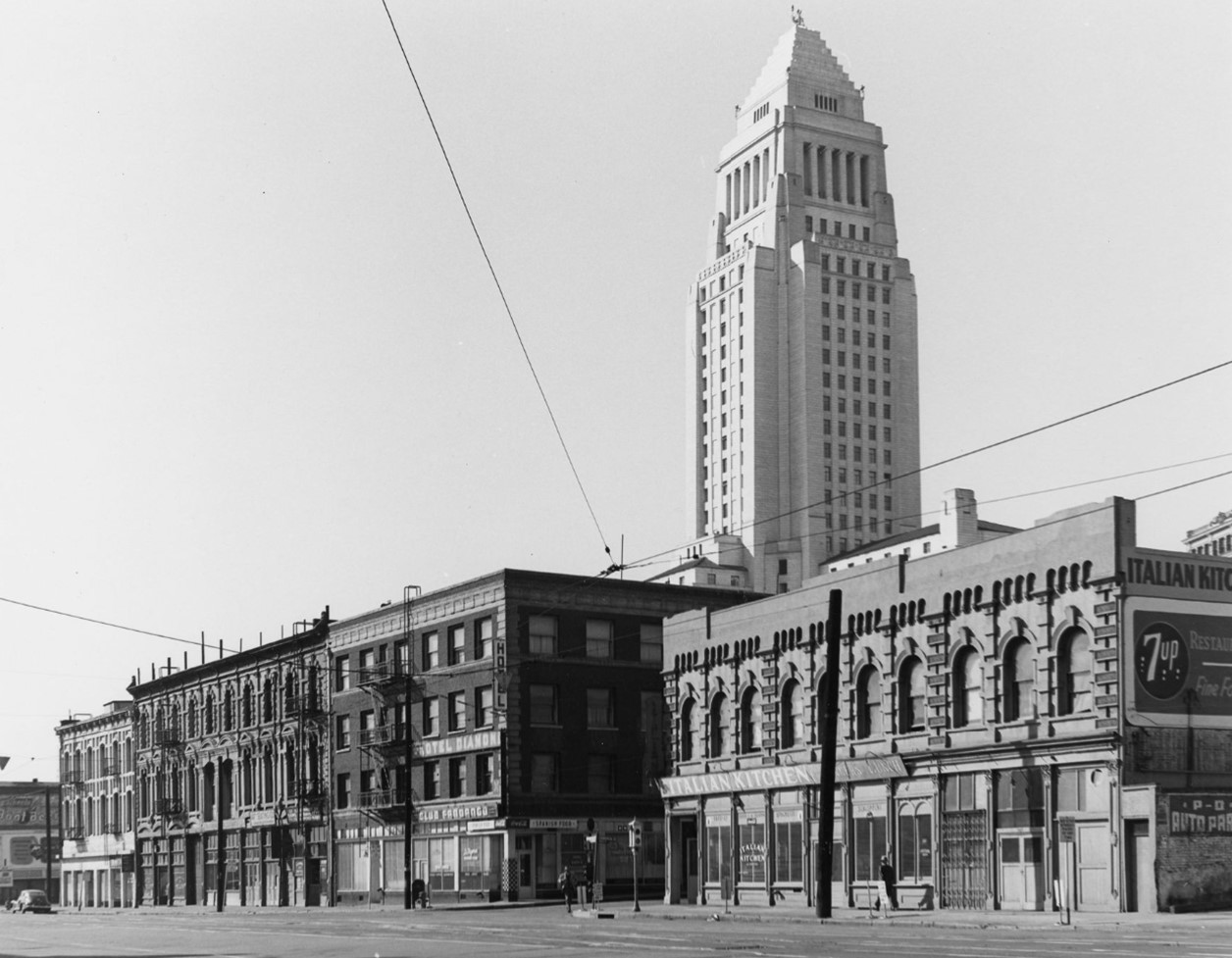 |
|
| (1950)* – View looking southwest toward the intersection of Los Angeles Street and Commercial Street, with City Hall in the background. In the foreground are two- and three-story brick buildings housing restaurants, hotels, and other shops. Photo by Arnold Hylen. |
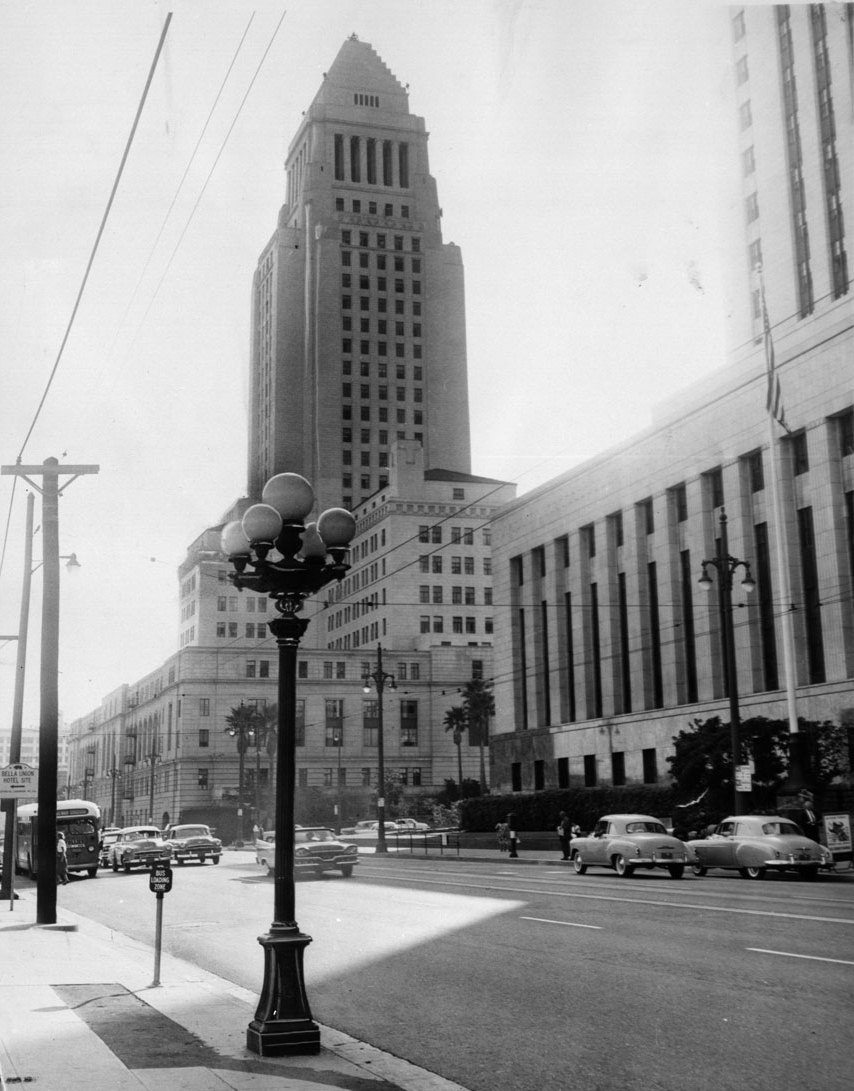 |
|
| (1959)* - Street view looking south on Main Street showing City Hall standing on the southwest corner of Temple and Main streets. The Federal Courthouse and U.S. Post Office Building is seen on the right. Note the beautiful 5-globe streetlight in the foreground.* |
Historical Notes The most common of the incandescent multiple globe electroliers of the early 1900s were those manufactured by the Llewellyn Iron Works of Los Angeles. The firm became so identified with this style of street light that any multiple globe electrolier became commonly known as a Llewellyn. The Llewellyn Iron Works, founded in 1889‐1890, was one of the largest metal working facilities in Los Angeles. It manufactured structural steel – including that for the Bradbury Building (1893). |
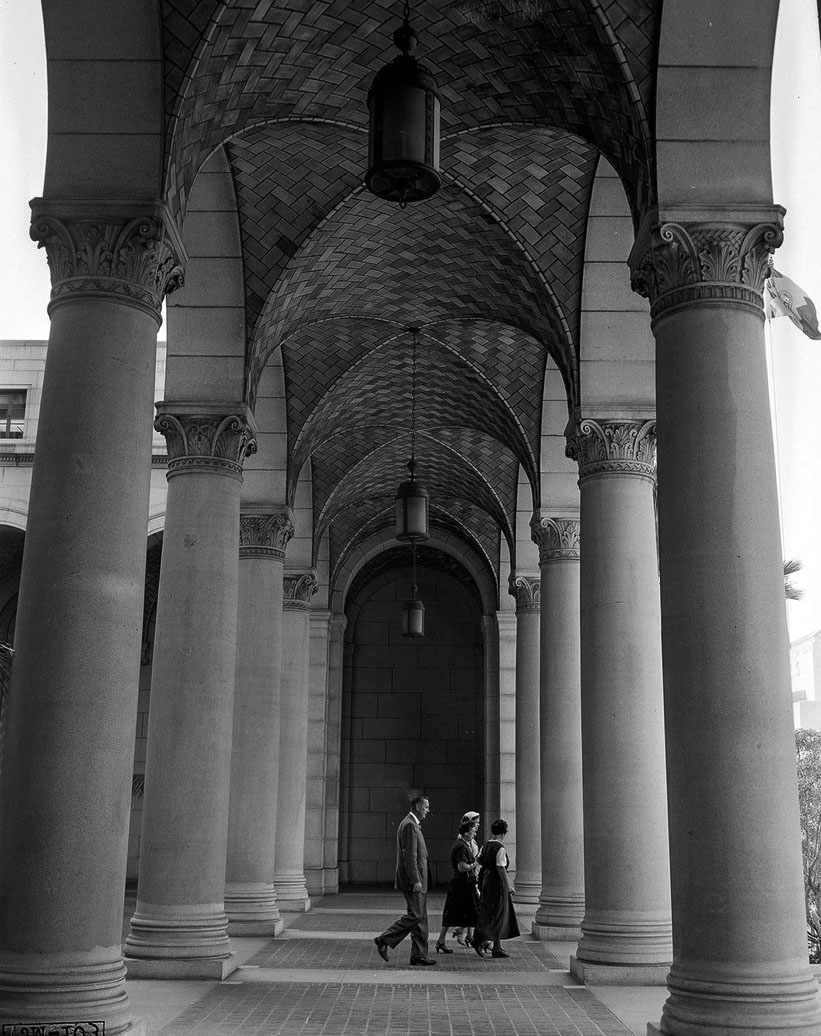 |
|
| (1955)* - Spring Street entrance to Los Angeles City Hall. This image led off the Know Your City photography series in the Nov. 18, 1955, Los Angeles Times. (Los Angeles Times Archive / UCLA) |
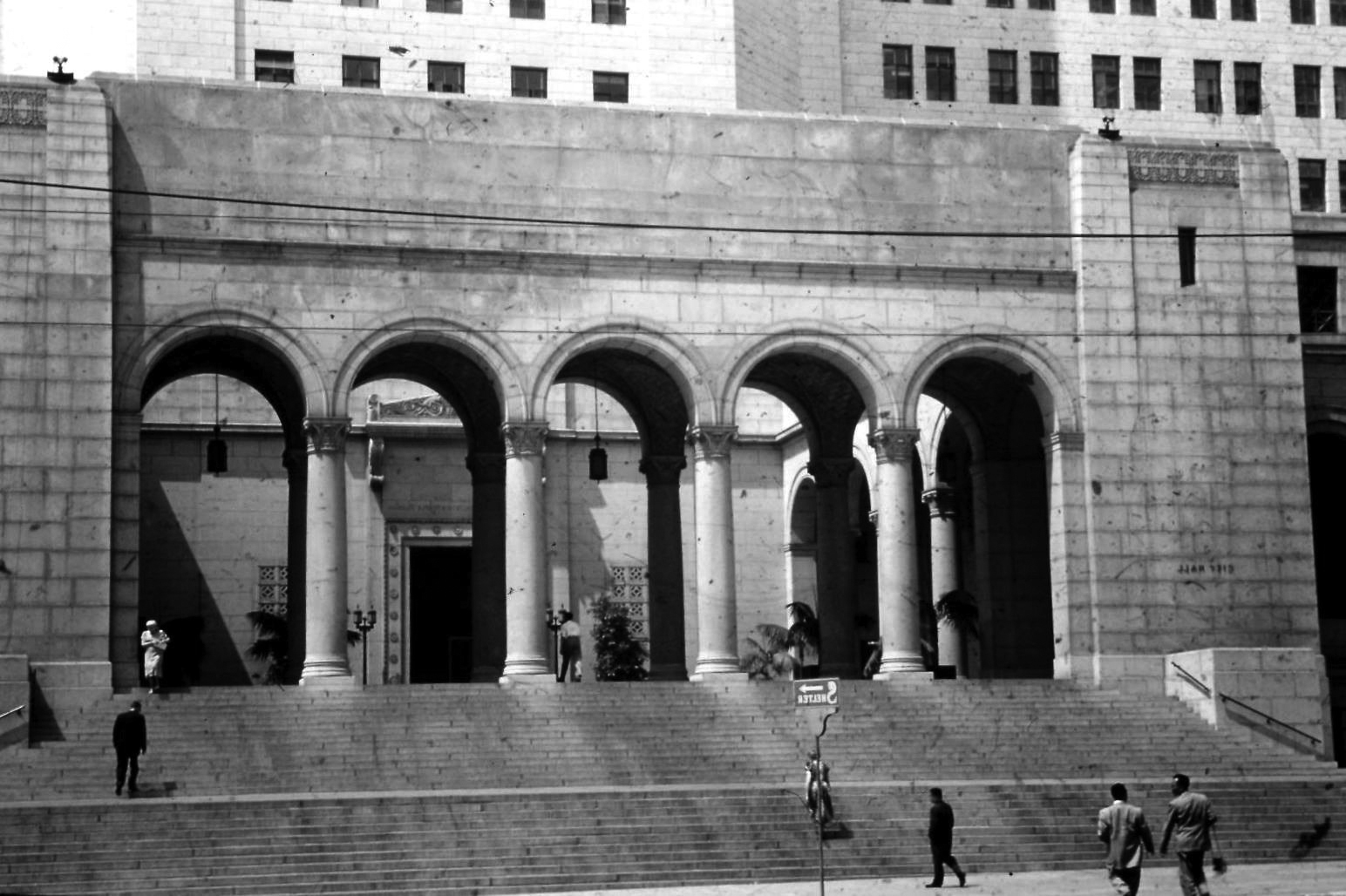 |
|
| (1950s)^ – View showing the steps to City Hall on the Spring Street side. |
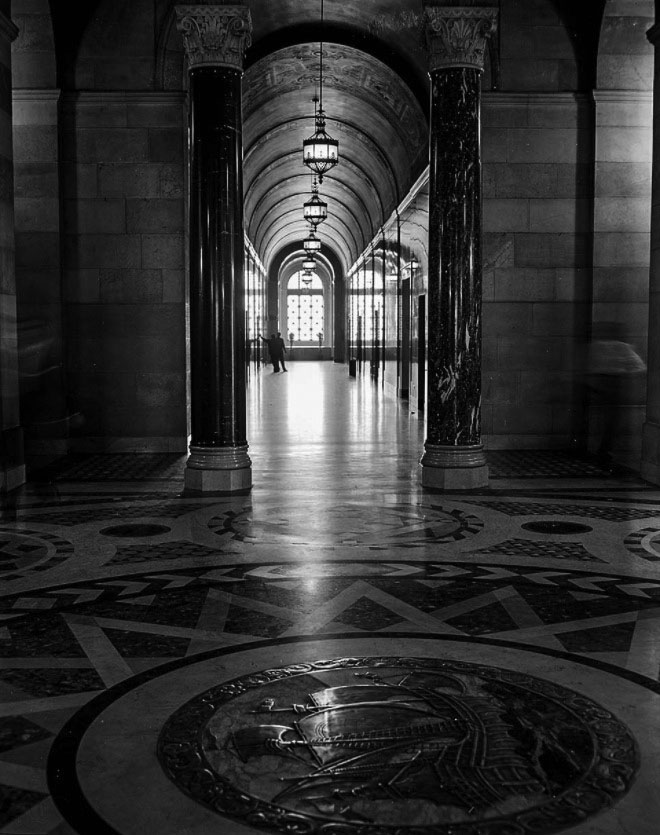 |
|
| (1955)* – View showing the south corridor on the Spring Street floor of City Hall as seen from the rotunda. At the end, to the left, the Mayor’s office; to the right, offices of City Councilmen. Note the bronze plaque set in the middle of the rotunda’s floor. |
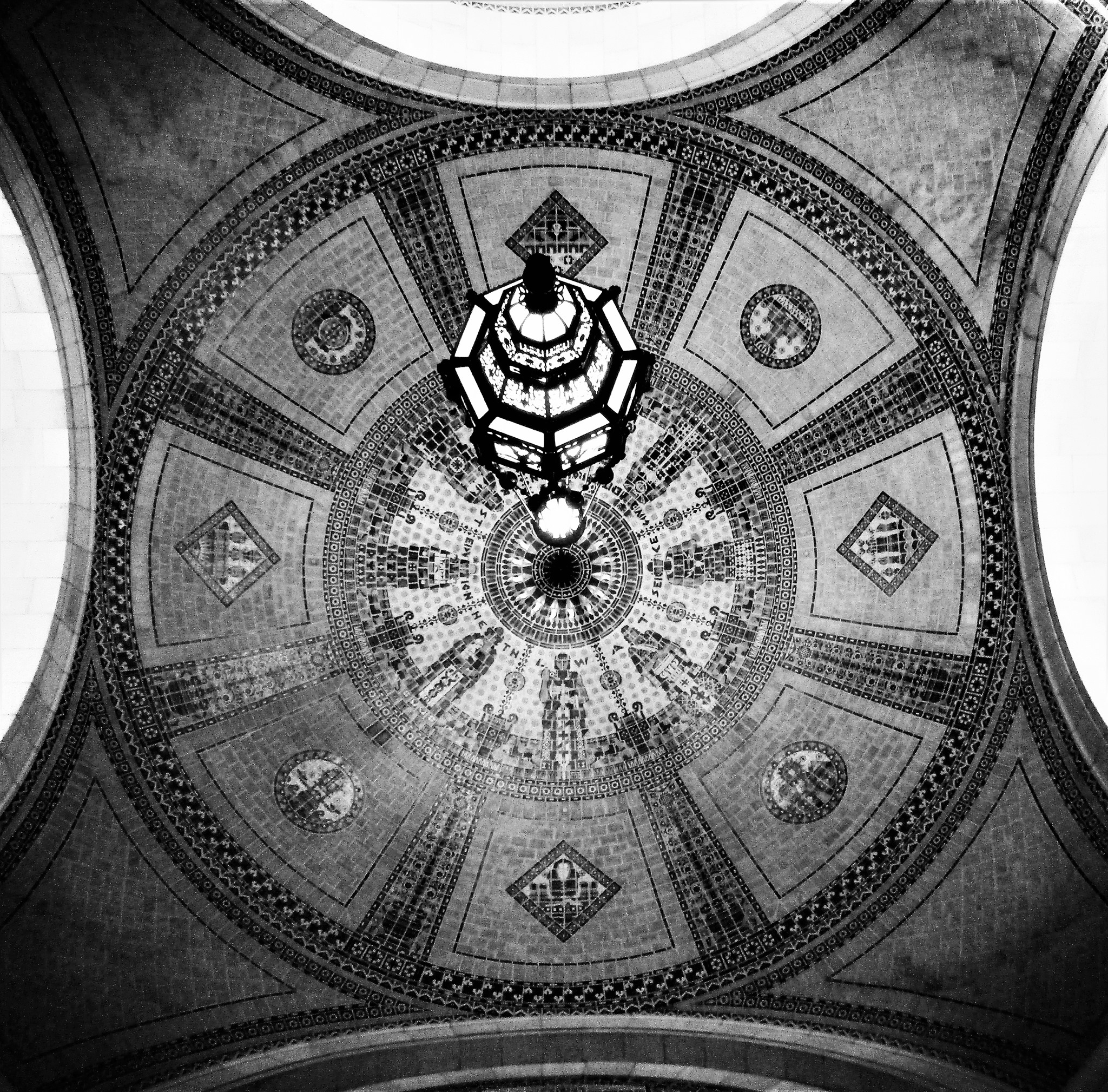 |
|
| (2021)* – Looking up at the beautiful ceiling of the City Hall rotunda located on the third floor. Photo by Howard Gray |
Historical Notes Architect Austin Whittlesey designed the interior of City Hall. Byzantine in style, it has huge vaulted ceilings, marble floors and perhaps its biggest feature, a giant rotunda high above the marble floor with ornate artworks and lighting fixtures. |
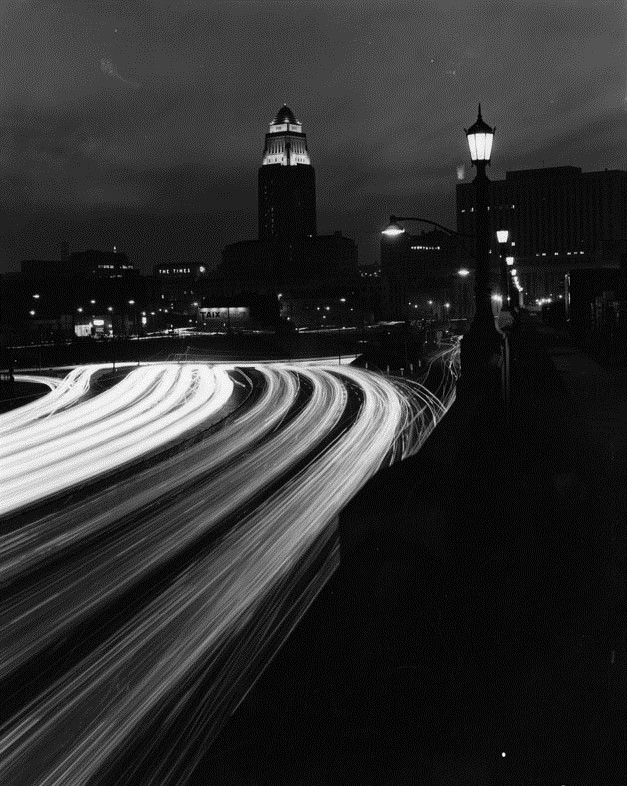 |
|
| (1962)* - Nighttime view of Los Angeles City Hall looking southwest from the San Bernardino Freeway. |
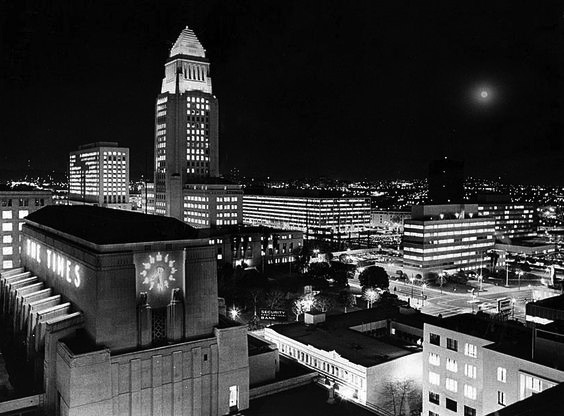 |
|
| (1969)^ – Night view looking northeast over the LA Times Building toward City Hall. With all the light, the city looks aglow! |
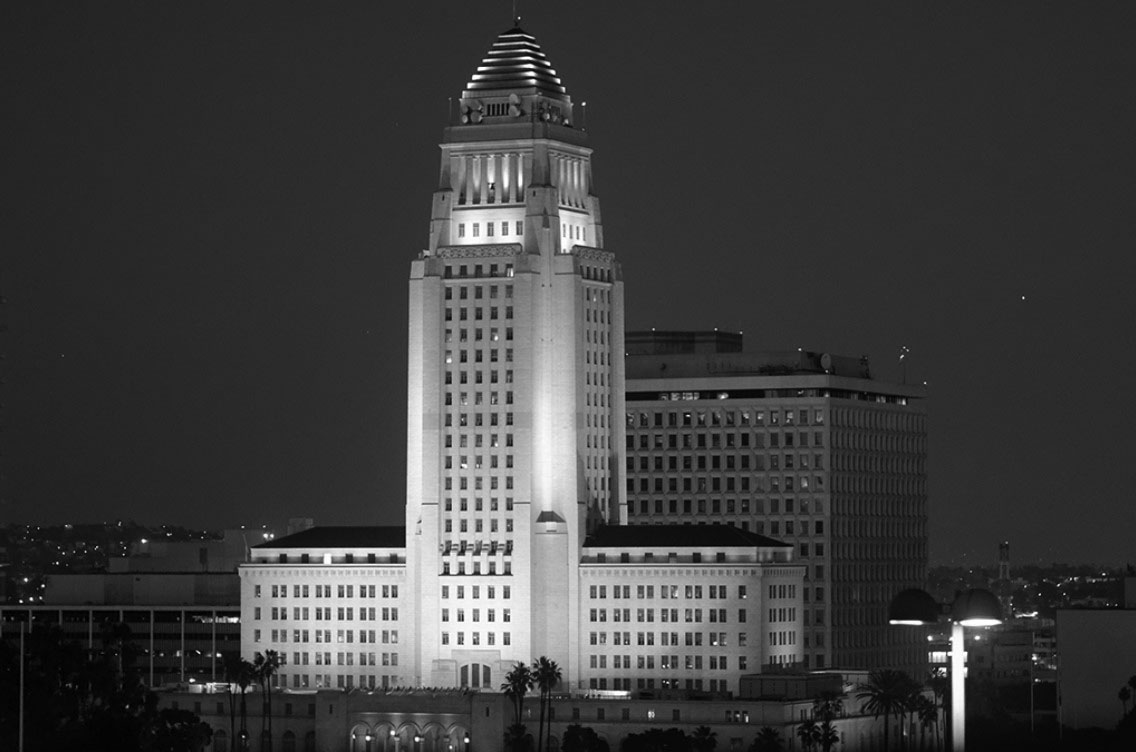 |
|
| (2013)* - View looking northeast showing City Hall at sunset. Photo by Michael J Fromholtz |
Historical Notes The building underwent a seismic retrofit from 1998 to 2001. It is designed to sustain minimal damage and remain functional after a magnitude 8.2 earthquake. In 1976, Los Angeles City Hall was designated LA Historic-Cultural Monument No. 150 (Click HERE for complete listing). |
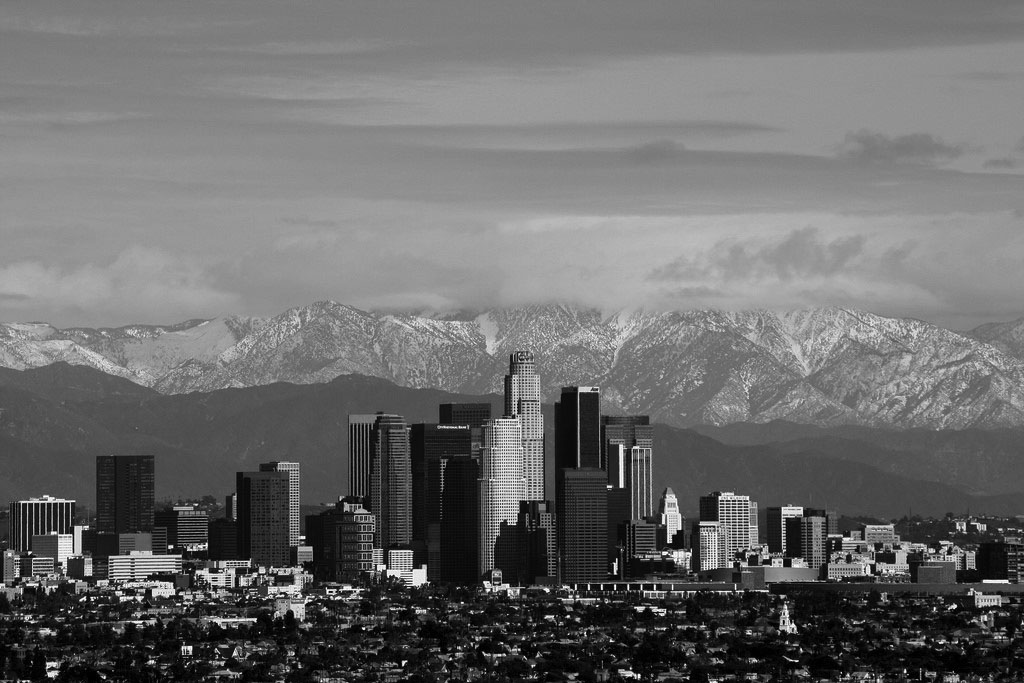 |
|
| (2013)* – City Hall in perspective. View looking northeast showing downtown Los Angeles with snow-capped San Gabriel Mountains in the background. City Hall is seen at lower center-right. Once the tallest building in Los Angeles (1928 thru 1964), City Hall is now dwarfed by scores of other skyscraper buildings. Photo by Todd Jones |
Historical Notes Los Angeles went through a large building boom that lasted from the early 1960s to the early 1990s, during which time the city saw the completion of 30 of its 32 tallest buildings, including the U.S. Bank Tower, the Aon Center, and Two California Plaza. The city is the site of 25 skyscrapers at least 492 feet (150 m) in height, more than any other city in the Pacific coast region. As of July 2011, there were 505 completed high-rises in the city. As of May 2011, there were 60 high-rise buildings under construction, approved for construction, and proposed for construction in Los Angeles. 37 of these 60 buildings are over 100 meters tall. |
* * * * * |
|
Other Sections of Interest |
|
Water and Power in Early LA |
|
Newest Additions |
New Search Index |

A new SEARCH INDEX has been added to help navigate through the thousands of topics and images found in our collection. Try it out for a test run.
Click HERE for Search Index |
* * * * * |
< Back
Menu
- Home
- Mission
- Museum
- Major Efforts
- Recent Newsletters
- Historical Op Ed Pieces
- Board Officers and Directors
- Mulholland/McCarthy Service Awards
- Positions on Owens Valley and the City of Los Angeles Issues
- Legislative Positions on
Water Issues
- Legislative Positions on
Energy Issues
- Membership
- Contact Us
- Search Index
© Copyright Water and Power Associates
Layout by Rocket Website Templates